
Curated by Tiago de Abreu Pinto
Audiovisual: Felipe Rios Fuentes
Anvisning: Voluspa Jarpa
Curatorial Assistant: Isidora Matta A
Juvenal Barría, Maricruz Alarcón, León & Cociña, Gabriel Holzapfel, Bernardo Oyarzún, Claudia Müller, Laura Ibáñez Kuzmanic, Juan Castillo, Fernando Gómez Balbontín, Norton Maza, Claudio Correa, Paz Errázuriz, Textileras MSSA, Javier Rodriguez, Gianfranco Foschino, Paula Baeza Pailamilla, Voluspa Jarpa, Daniel Reyes León, Mariana Najmanovich, Delight Lab, Ana Carolina Tapia, Estela Ortíz, Irene Abujatum, Josefina Guilisasti, Marcela Correa, Marisol Lara, Sandra Radic, Cristóbal Cea, Paula Martínez Pastorino, Enrique Flores, Sebastián Mahaluf, Victor Hugo Bravo, TEMET, Ángela Cura, Felipe Santander,Milena Moena, Cristian Inostroza, Raimundo Edwards, Francisco Peró, Flavia Contreras, Francisca García, Mario Navarro, Raúl Zurita, Rodrigo Arteaga, Andrés Durán, Miguel Soto, Francisco Belarmino, Valentina Maldonado, Victor Flores, Trinidad Lopetegui, Constanza Alarcón Tennen, Pamela Iglesias Carranza, Pilar Quinteros, Ximena Zomosa, Sebastián Calfuqueo, Francisca Aninat, Andrea Cifuentes del Río, Benjamín Ossa, Mil M2, Javier Toro Blum, Rodrigo Castro Hueche, Dano Mozó, Juan Pablo Mejías del Pino, Nicolás Franco Guzmán
al aire, libre (free, in the open air) is a small gesture that alludes to the public, something that was lost in these days of isolation. Previously, connected to a movement of change, now spectators of a suspended space, postponed.
A public art project, with more than 70 artists and artist collectives, that occurred mostly during May 16-17, 2020. It consisted of an ephemeral exhibition in Chile of physical works and actions that were connected under the spirit of the project but far from each other (from Copiapó to Coyhaique), in the context of the quarantine. A diluted exhibition, but one that connected the Chilean territory.
Its conceptual framework deals with the current state of isolation/quarantine focusing on answering questions regarding perception: Are we anonymous beings to our neighbors? If no one is around to hear us, do we make a sound? This led artists and artist collectives to develop works with a biopolitical, social, collaborative, relational, intimate, natural, poetic and scriptural overtone.
Bernardo Oyarzún
Mawün (Rain), installation, May, 2020, Cabrero (Chile)
Installation in the landscape, specifically on the yellowish autumn grass. It consists of the anchorage on the ground of several dozen vertical rods of approximately six meters and about five centimeters in diameter, gathered in a semicircular formation. Each of these rods on top has a suspended water container object, specifically metawes (Mapuche: clay). The idea pursues a sort of post-modern ritual with sacred containers of the Mapuche culture, waiting for the rain that will come from the sky in the mean and apocalyptic context of the theft of water and the traffic of water sources in Chile.
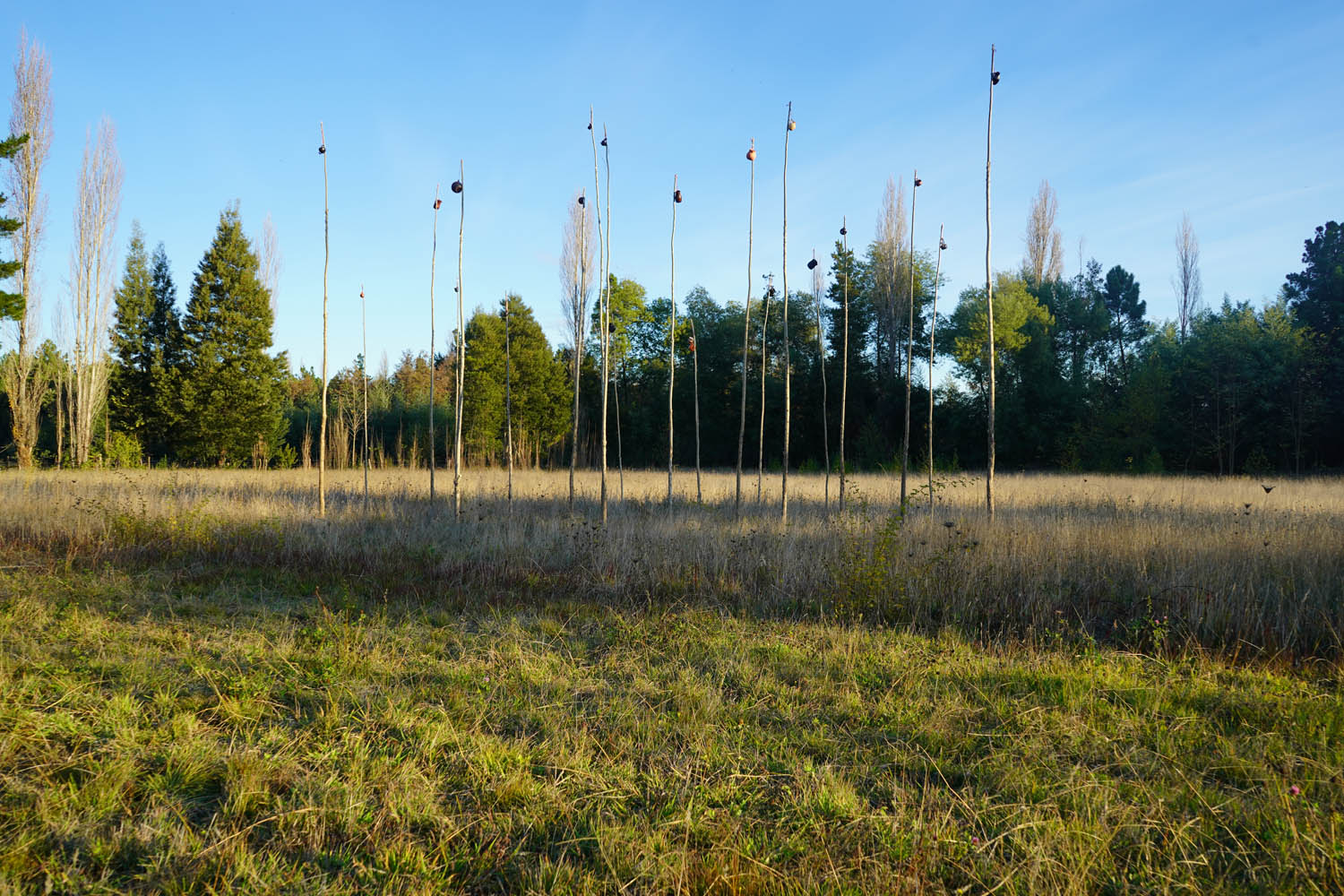
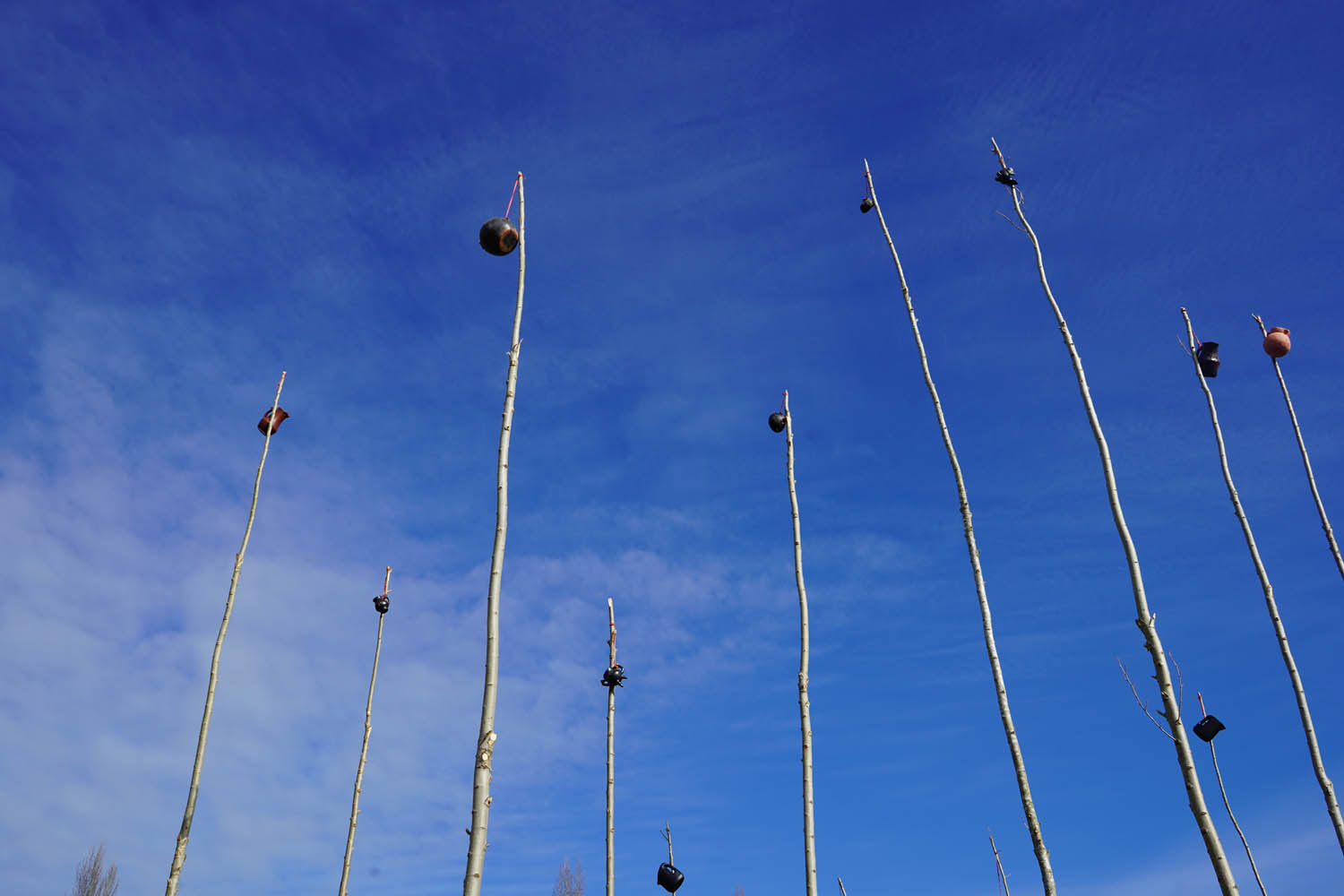
Andrés Durán
Ofrenda (Offering), installation, May, 2020, Santiago (Chile)
“My proposal was to use a large window in my house in the Ñuñoa district, to make a rear projection of video and make it visible from the passage where I live. The video that I presented is a reissue of the video installation Ofrenda (2017), it shows the loop of a woman who carries with her a particular floral offering. On this journey, the woman transits the edges of the Northeast sector of Santiago, crossing neighboring areas on a constant pilgrimage.
In Ofrenda, the contrast between a landscape both urbanized and bucolic – the absence of people on the streets and the urban development of the sector – contrasts with the minimal and intimate actions of the protagonist.”
Cristóbal Cea
Viaje Astral #2: Interfaces, Museos y Tablets (Astral Journey # 2: Interfaces, Museums and Tablets), Performance, May, 2020, Santiago (Chile)
Tomás rests under the shade of a palm tree.
Like many artists, the health crisis involved indefinitely canceling or postponing exhibitions, residences, and trips that I thought were important to the future of my career. However, the future came the same, so I assume that they were not so important for the future in general or for my career in particular. When I assumed this I took the quarantine situation as a starting point to abandon any plan and aspiration: understanding that during periods of uncertainty, the only sensible way to continue creating is to open up to the creation of indeterminate, open works, devoid of any type of certainty , preconceived image or long-term speculative strategy.
These quarantine drawings – I still don’t know what they are called – started as the creation of a habit. One that would hopefully light up this moment, and help me make peace with the present time.
Reimagining the now obsolete practice of drawing doodles while talking on the phone, I began to call people while simultaneously drawing on a graphics tablet an uncertain doodle that its process of realization is captured as a “speeddrawing”. The resulting videos, which last between 3 and 90 minutes, are the remnant of an incomplete conversation, where what remains is my voice, a drawing that I do not know what it means and the unintelligible murmur of someone on the other side.
Lately thought a lot about Claude E. Shannon’s Mathematical Theory of Communication. Particularly on the diagram where communication is defined as the problem of eliminating the noise that is placed between who emits a message and who receives it. It is not clear to me what is the problem with noise: what is wrong with half listening or occasionally confusing things?
This habit of talking doing other things that I have had for a couple of months has fortunately undergone some modifications. Like the one in this video where I choreograph to cover the window of my house with a green screen (perhaps an invitation to be intervened), look for a friend with a drone and not be able to see him well for measuring just a few pixels (thanks Milestone) and then draw a conversation about the sound of the violins.
I suppose exercises such as these are attempts to inhabit the social distance that today is “the new normality”: seeking to find a form of creation that is located in the undifferentiated zone between the artist, the work of art and the person who receives this work as a message : be the person (s) with whom I talk, who take the time to want to check my social networks or someone who reads these lines on a web page
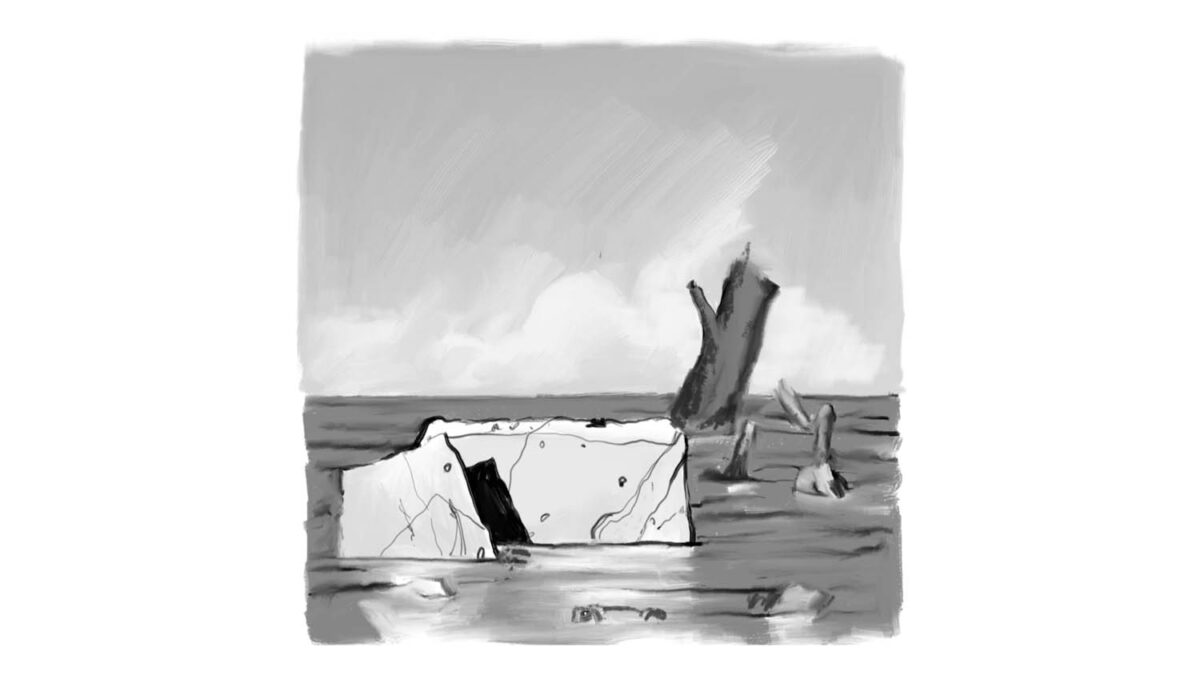
Delight Lab
Esto también pasará (This too shall pass), Site specific projection on Telefonica Tower, May, 2020, Santiago (Chile)
Large-scale lighting intervention in the city with the phrase ‘This too shall pass’ corresponding to an ancient fable by an anonymous author. This fable says that both in moments of crisis and moments of great happiness occur and pass, so you have to anchor yourself in the peace of the present, nothing is permanent, everything is dual.
La vida es muy hermosa incluso ahora (Life is very beautiful even now), Site specific projection on Telefonica Tower, May, 2020, Santiago (Chile)
Sentence from the book Purgatorio de Raúl Zurita projected in the Telephone Tower with the support of Delight Lab
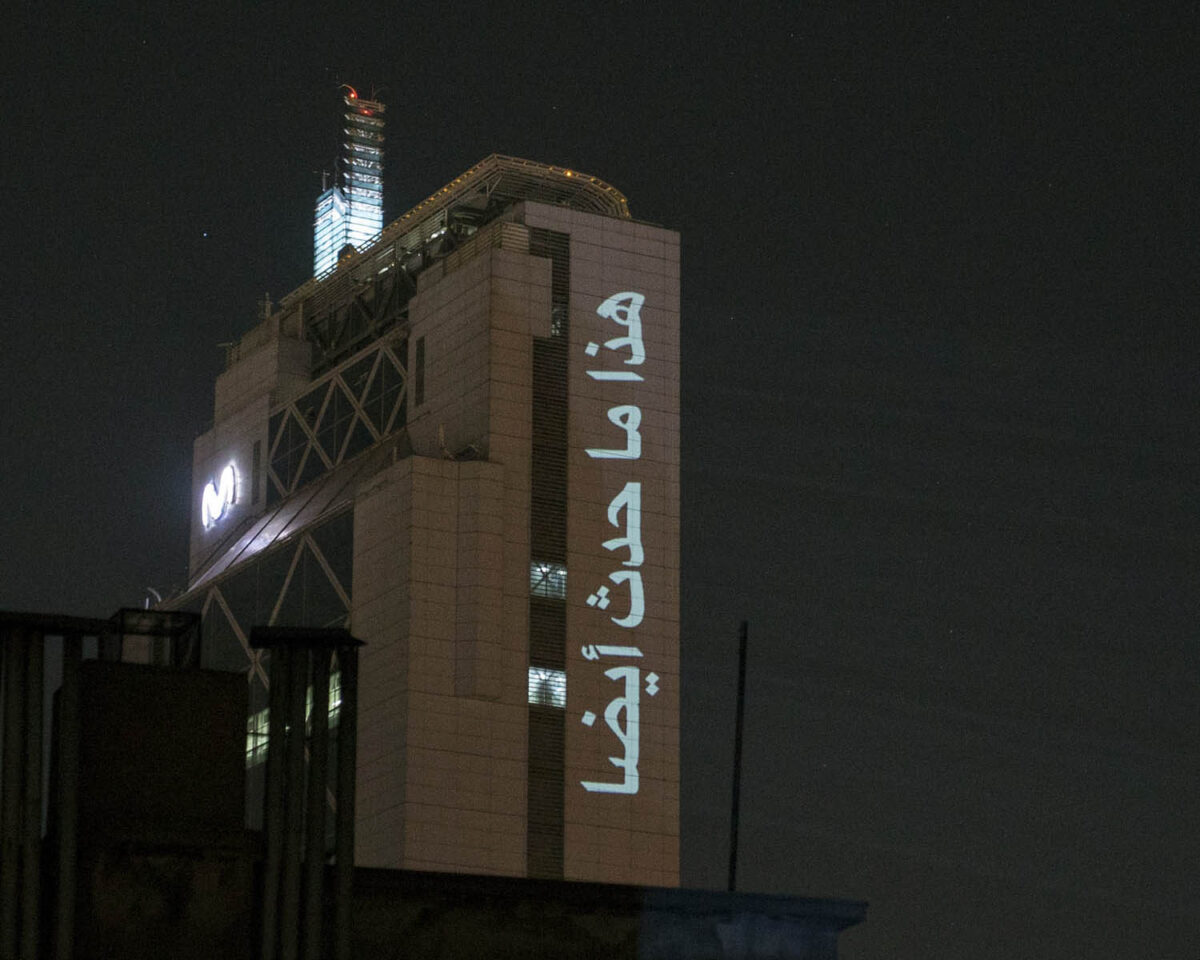
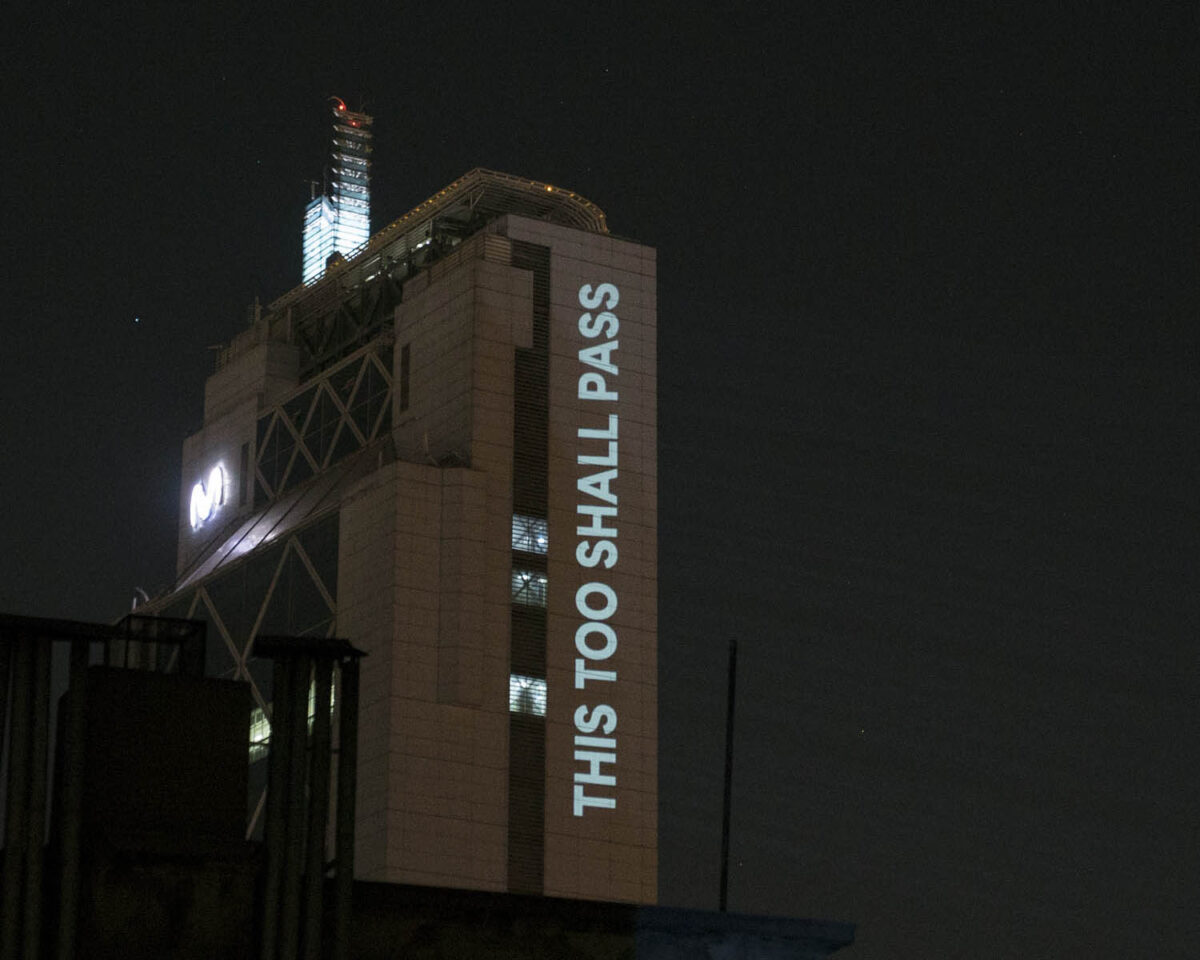



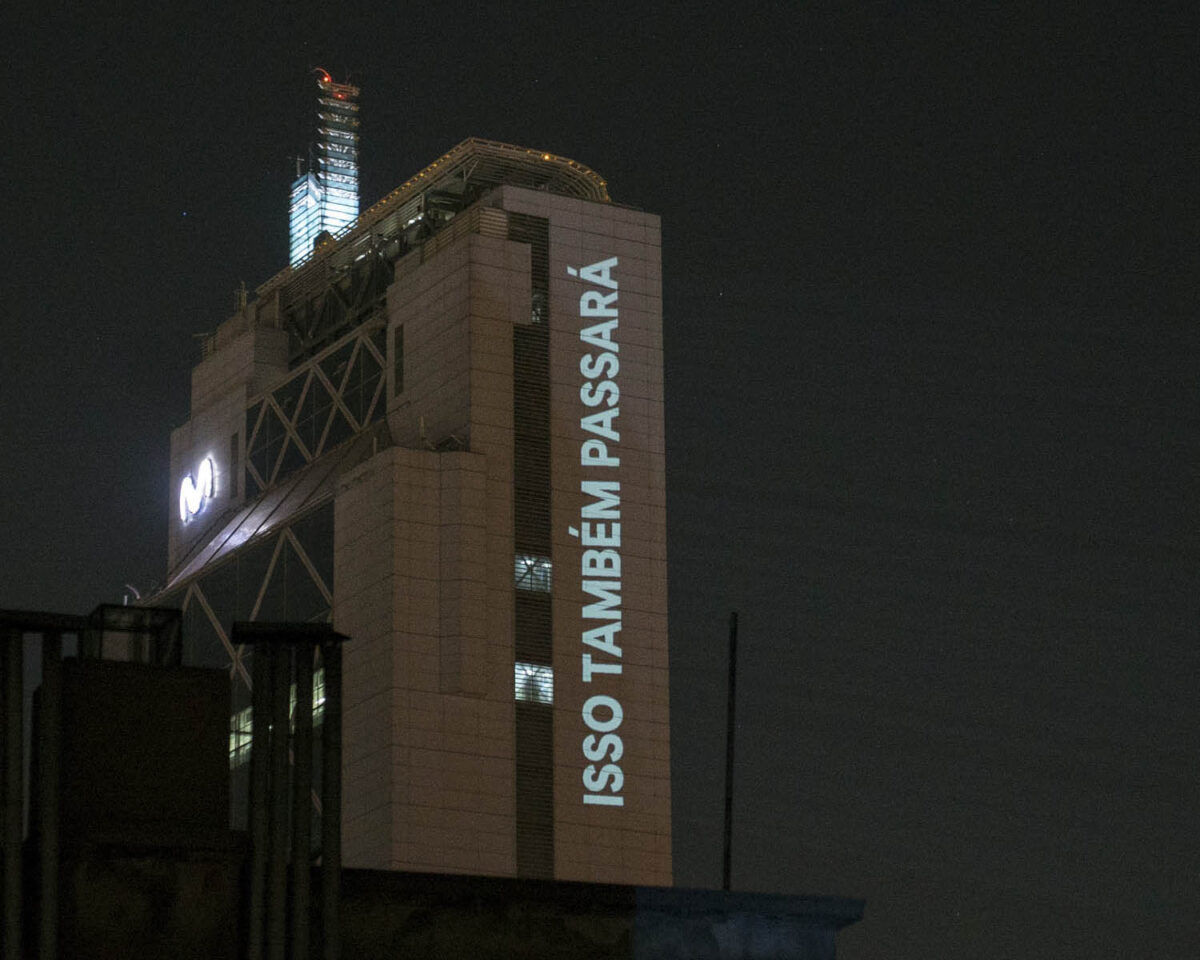
Javier Toro Blum
DOMO (DOME), Light projection, May, 2020, Santiago (Chile)
The project consists of illuminating from the window of our room the east face of the dome of the Iglesia de los Santos Ángeles Custodios, using two high power led spotlight (500 Watts). The cold lighting contrasts with the warm light, from public lighting, opposing both points of the light spectrum. The Church is a nerve center within the Obispos neighborhood, with views from multiple points. The illumination of only one of its face gives back to the dome a moonlike atmosphere, where face and its opposite make a chiaroscuro that varies according to the point of view of where you look. In this way the architecture is modified without being physically intervened, open to multiple views from our own homes. Through light, a unified system is built between two buildings, which is capable of being shared within the neighborhood from its multiple possible images. The object appears and disappears in movement, as a form that contains light and darkness, being an ephemeral mirage of its own image.

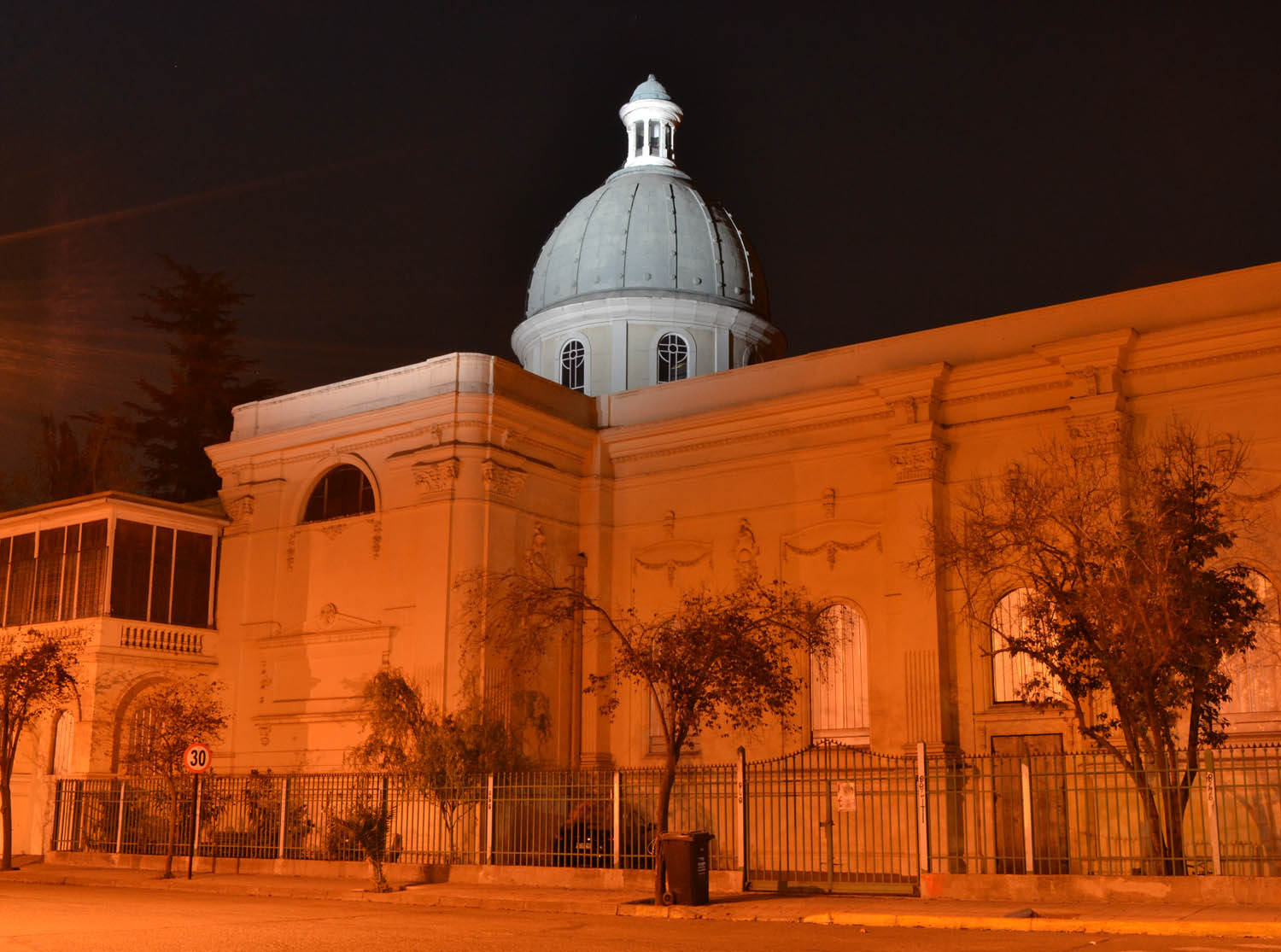

Juan Pablo Mejías del Pino
Sin titulo (Untitled), installation, May, 2020, San Fabián de Alico (Chile)
In times where daily, normal and simple freedom, going for a walk, has been interrupted by the pandemic that isolates us. What yesterday was going out, getting together with others, greeting, kissing, hugging, today is nothing more than a possibility of constant risk, making various silenced questions appear, which appear in a disruptive way.
Everything has changed, there are no longer the meetings, the social meetings, the cruising, the parties and the group and collective overflow of which many of us were part of.
In my case it is a change of life, which first went through the change from the city to the countryside. I did it without knowing that a pandemic would soon arrive, which places us as spectators. The impossibility of going in search of eroticism, of the encounters I enjoyed, makes me wonder where were my emotional stabilities?
Part of it was my desire for men. That desire stabilized me, connected me with my emotions. Now nothing, from this isolation and loneliness, from a voluntary quarantine this need arises to build me a sublimation. Everything to which he could choose was interrupted by the impossibility of interaction with another/s.
From there I begin to make a series of male portraits in painting, recalling the act of meeting another, an evocation that builds a story in the forest, a visual and sound fantasy. The interaction between an oak forest intervened by these portrayed men, are my answers to look for the other, to experience the present and find my emotional and erotic stability.
The series of portraits is made up of 8 paintings in the technique of oil on wood of 30 x 25 cm each. The interventions in the oak forest have a strict relationship with my environment, where I’m living. Aware that I’m fortunate of the landscape, of the outdoors, but experiencing the isolation where painting and its intervention in nature, is presented as the experience of others as ghosts.
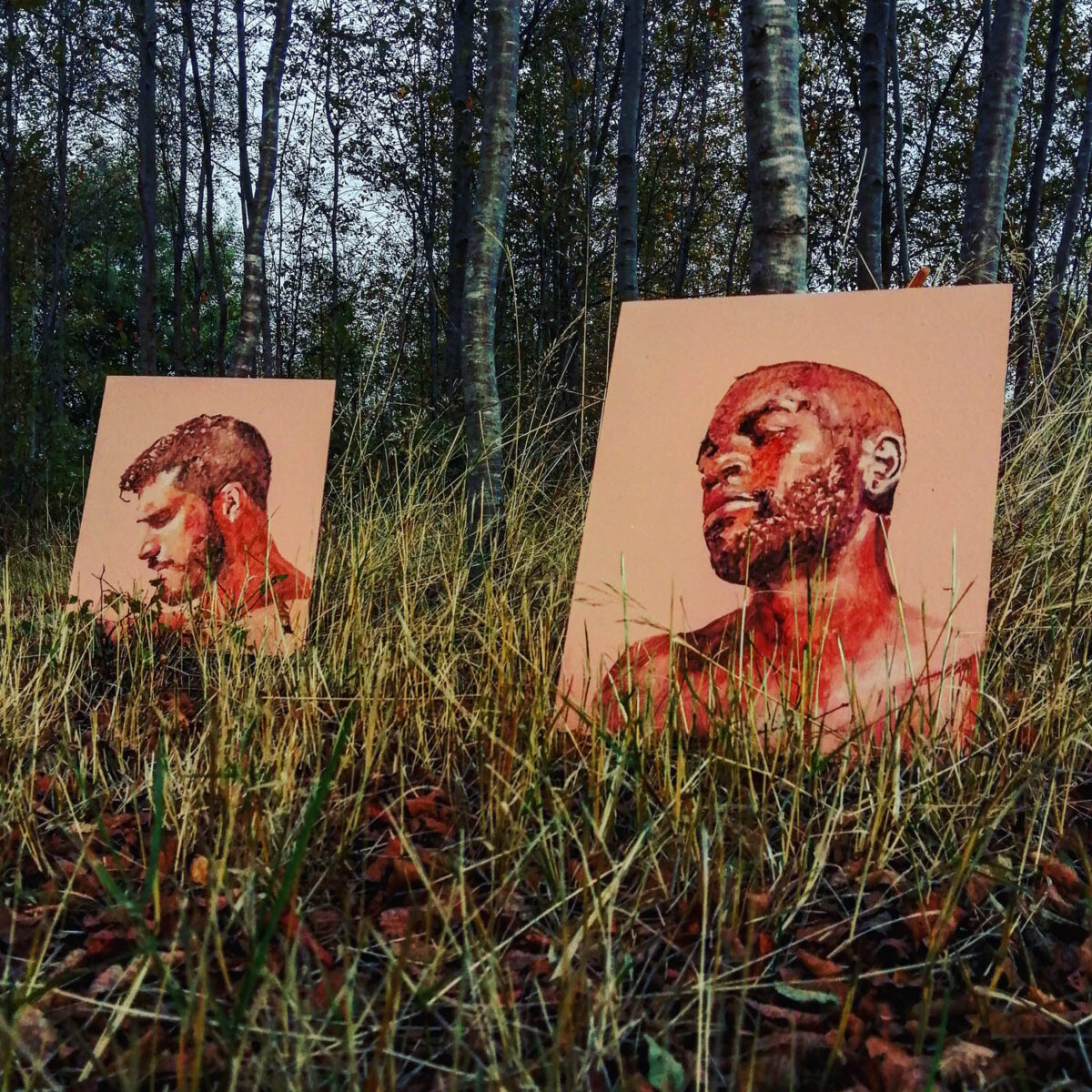
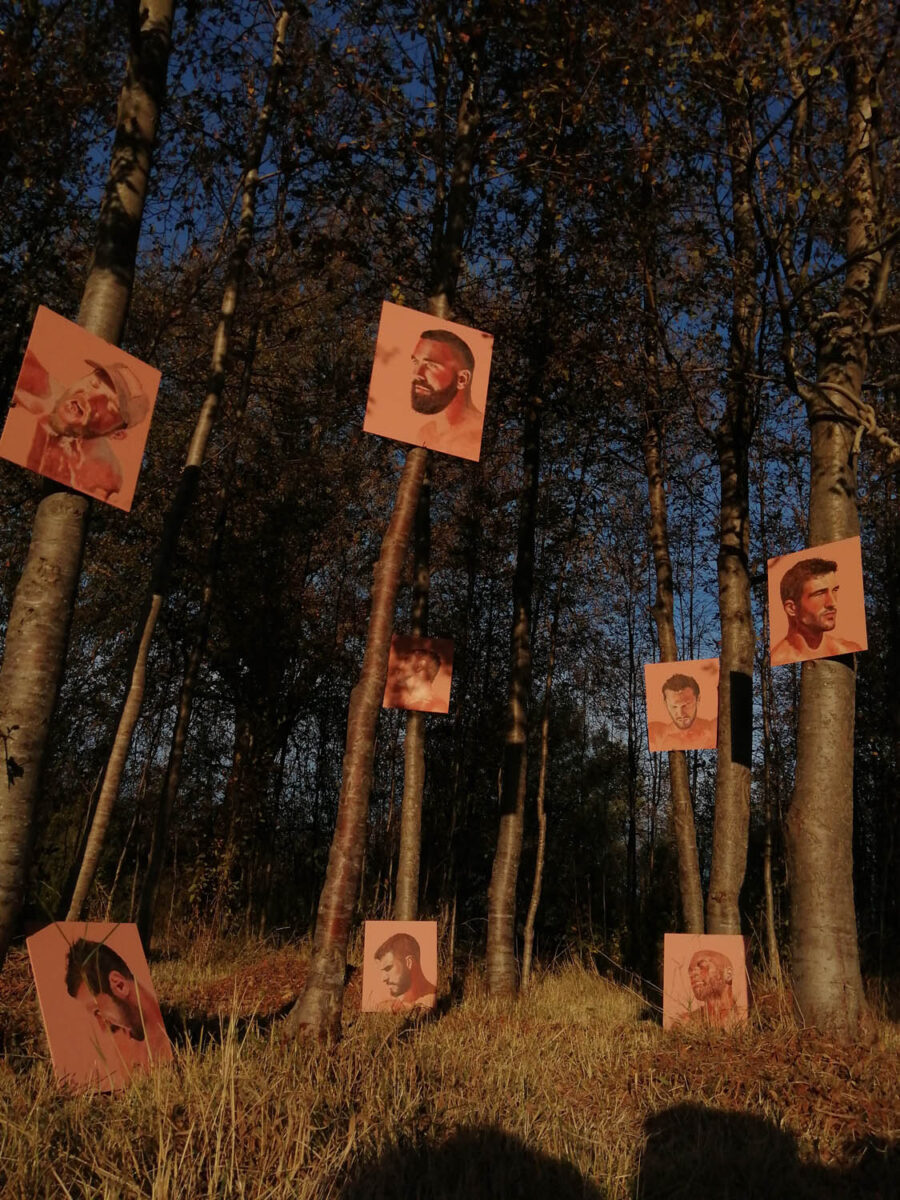
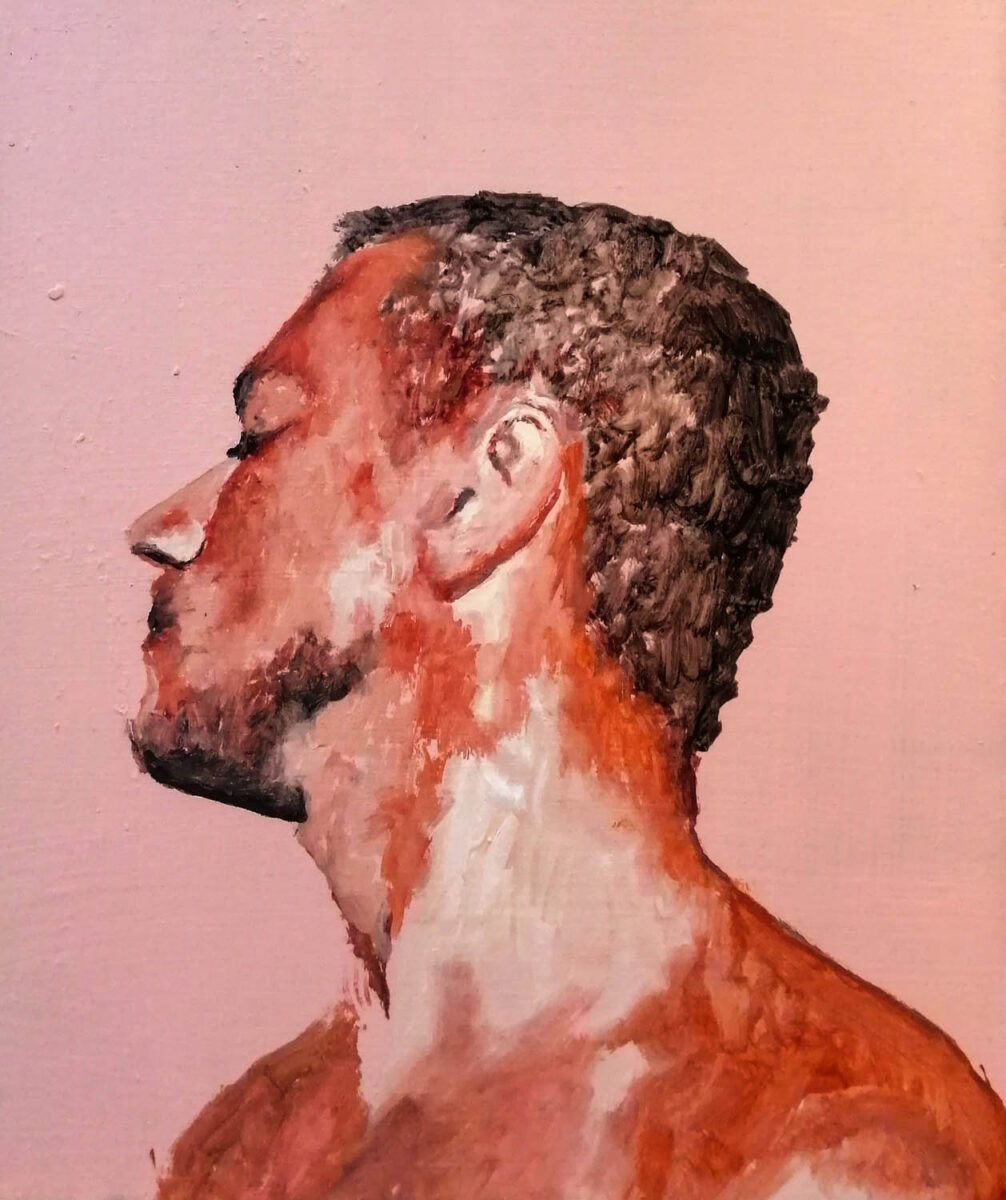
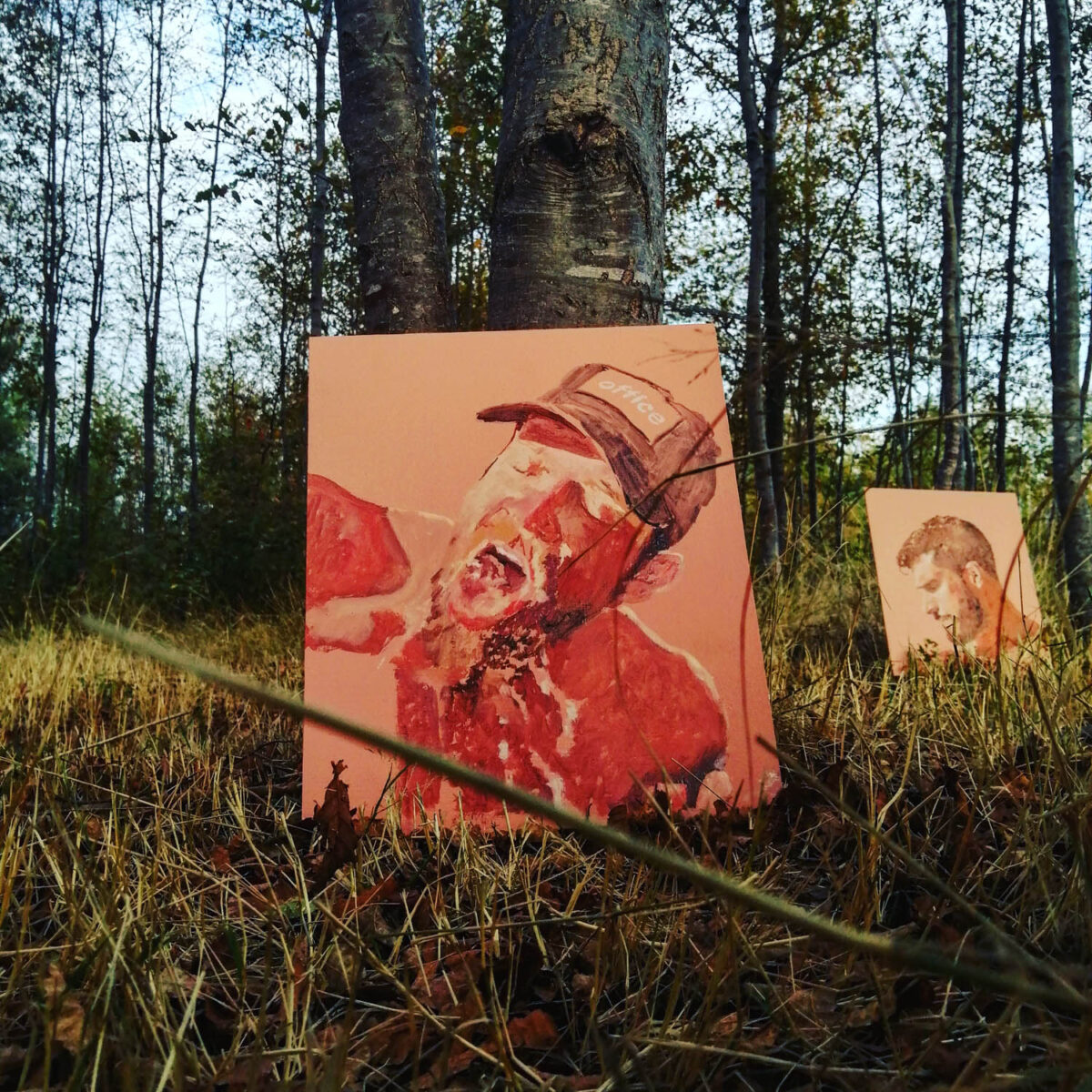

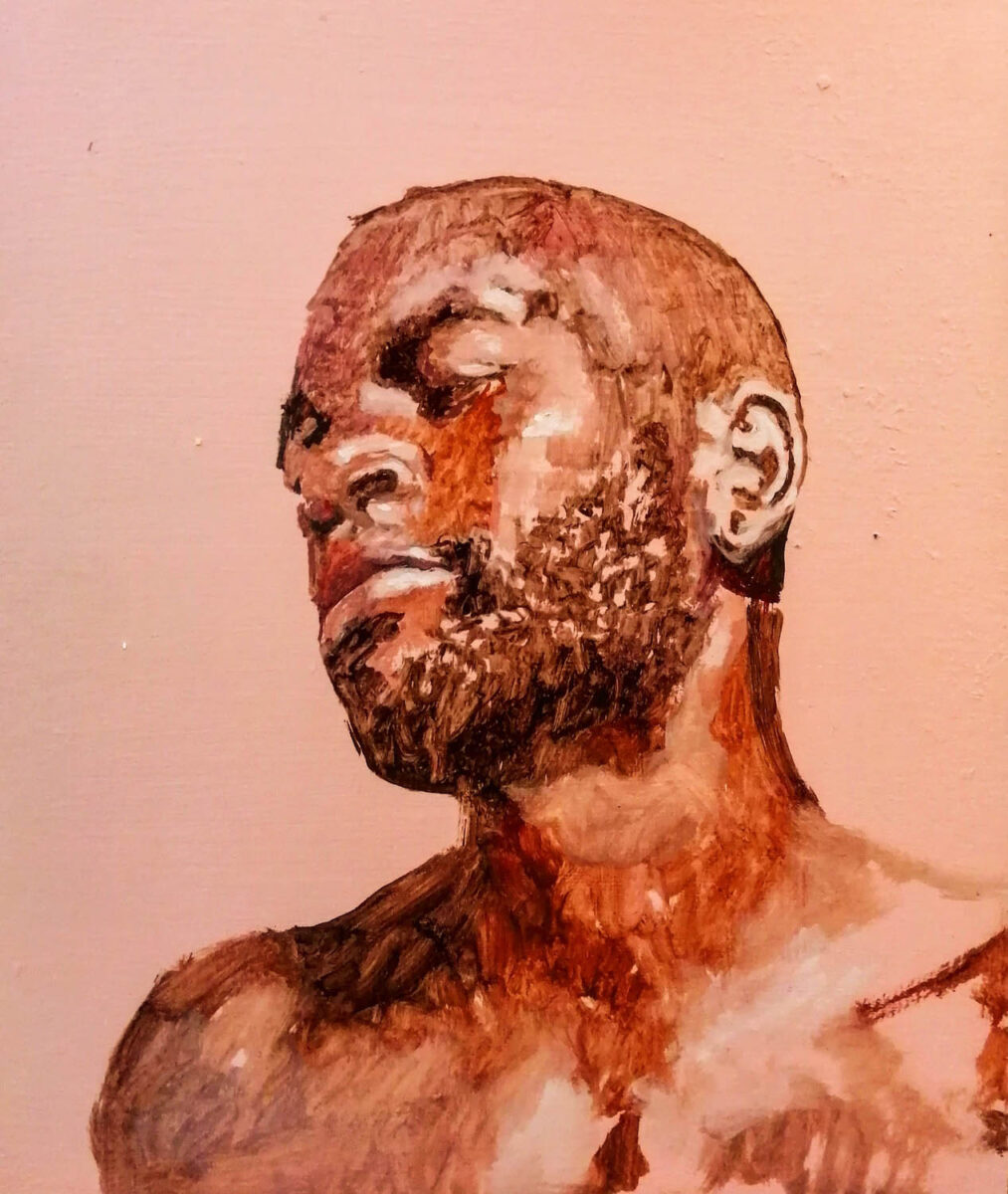



Paula Baeza Pailamilla
PU DAWÜL / EN EL CHARCO /IN A PUDDLE, Performance and site specific installation
May, 2020, Santiago (Chile)
Performance carried out at the place where I grew up and still live, maternal home located in one of the peripheral communes of the Metropolitan Region: Pudahuel, that in the Mapuche language means “in a pool”, or puddle that forms on the ground after raining.
A court of a villa, a place to grow my mother’s lawen (medicinal plants), a small piece of land where I can breathe and avoid confinement. A reduction in life that makes us notice the limited spaces in which we grew up and used to live.
Miguel Soto
Sin Titulo (Untitled), Site specific installation, May, 2020, Santiago (Chile)
Wooden sculpture that goes out of the window of my room towards the public space or enters from the public space to the private one.


Mil M2
¿Qué pregunta es urgente hacer/nos? (What question is urgent to ask/us?), Performance and Site specific installation, May, 2020, Santiago (Chile)
What question is urgent to ask/us? It is an invitation from Mil M2 collective to a group of neighbours of Torres de Tajamar in the Providencia district. A group of neighbours gathered, in the social movement of October 2019, have made visible through posters and canvases, different demands from their panoramic windows. Likewise, we invite you to use the Project Question methodology to amplify your voices and reflect on new/old emergencies that are revealed to us today.
Starting from a very simple action protocol, using photocopies and paper, we invite this community previously organized through a WhatsApp group, to doubt, question, think and share these new emergencies remotely. Through an exchange of messages and the use of different dispatch methods, the action concentrated a group of answers/questions on the different faces of the A, C, and D towers of the housing complex. The project was carried out in collaboration with Andres Soffia Vega, Cabildo Tajamar and Virginia Migani.
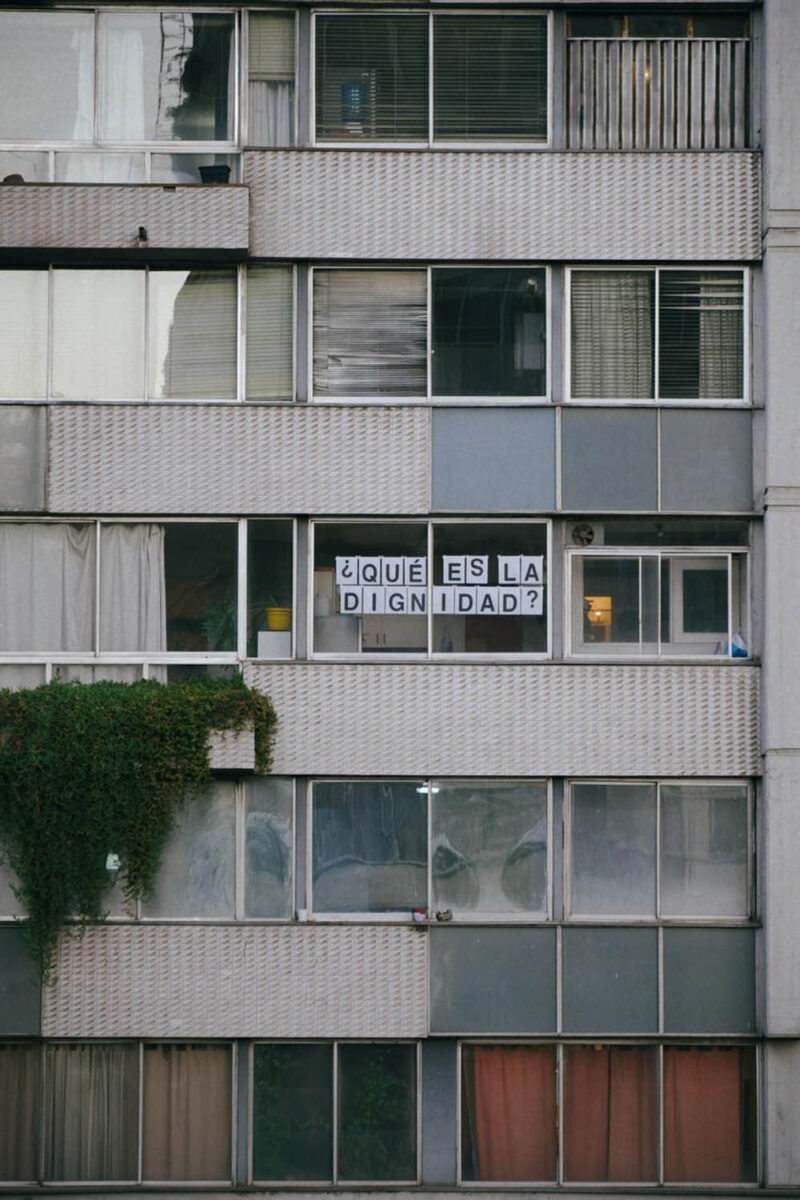

Nicolás Franco Guzmán
Parcours d´incidents, Site specific installation, May, 2020, Santiago (Chile)
Multiple sculpture of aluminum profiles and plates that function as a support for the assembly and development of a flow of enigmatic and affective relationships between language, images and architecture

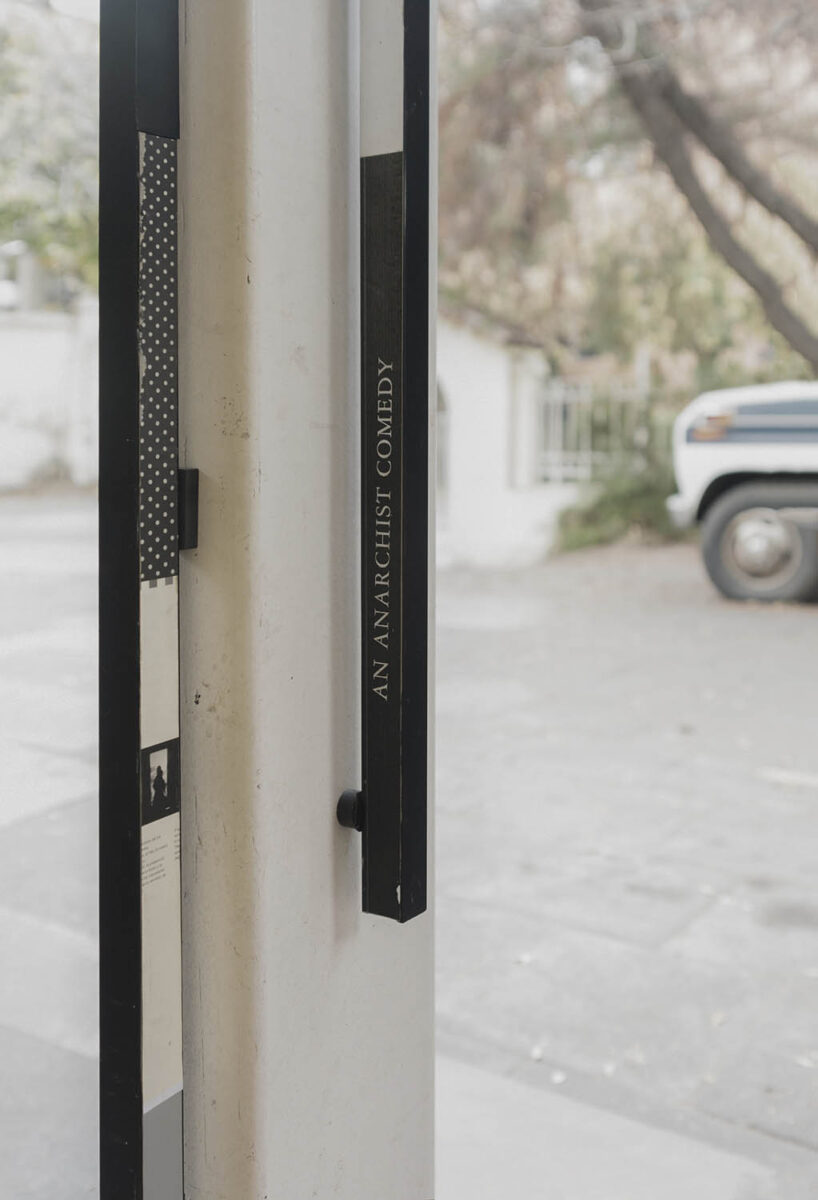
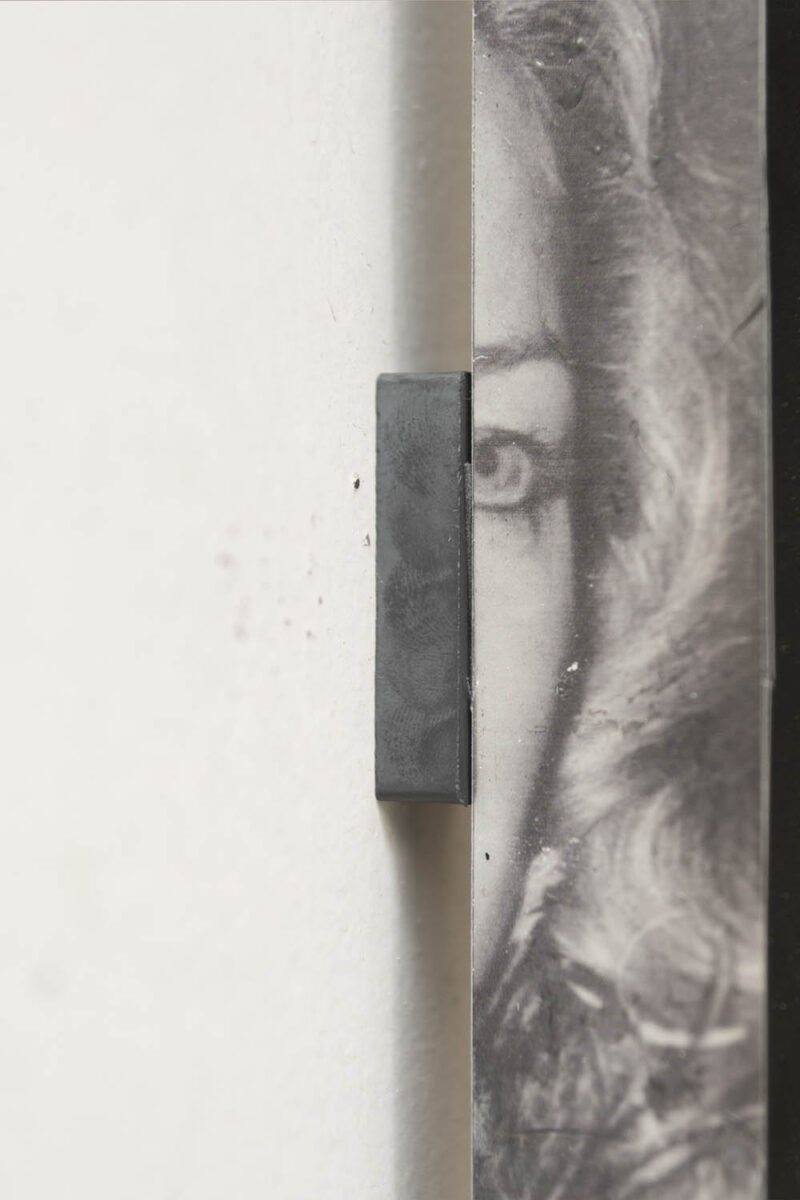
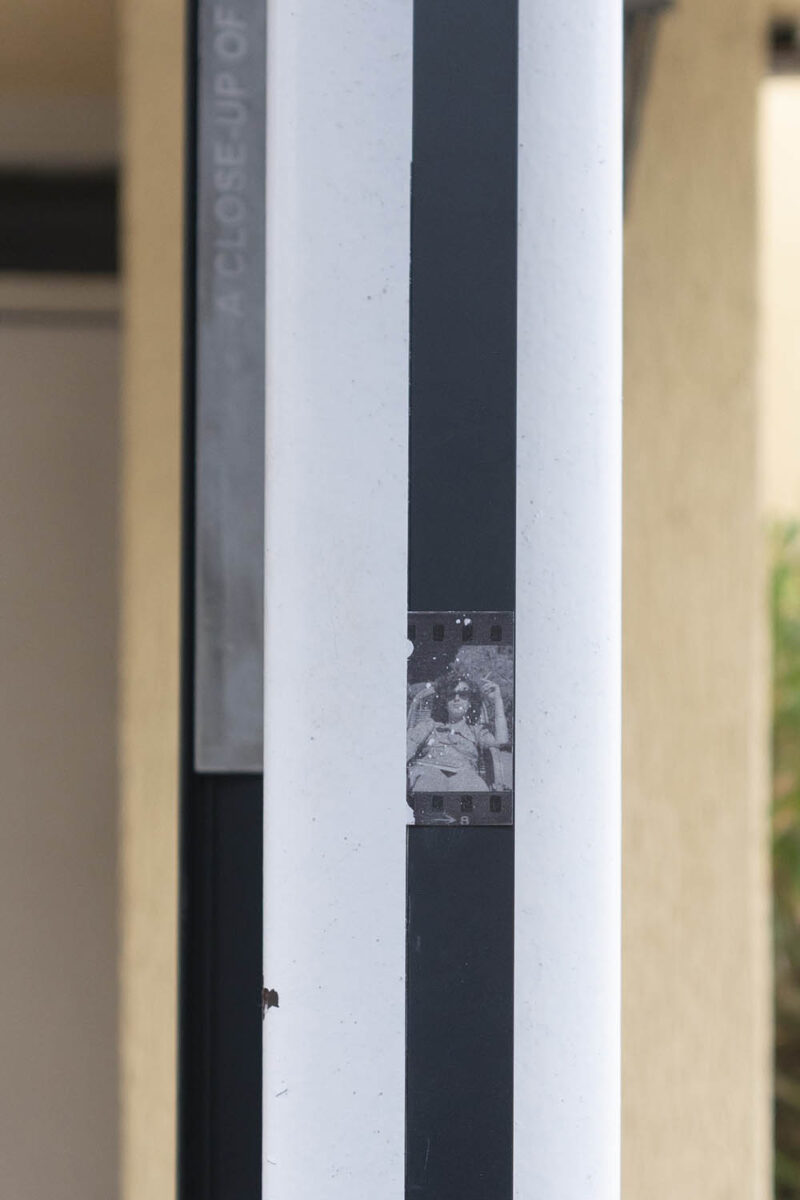
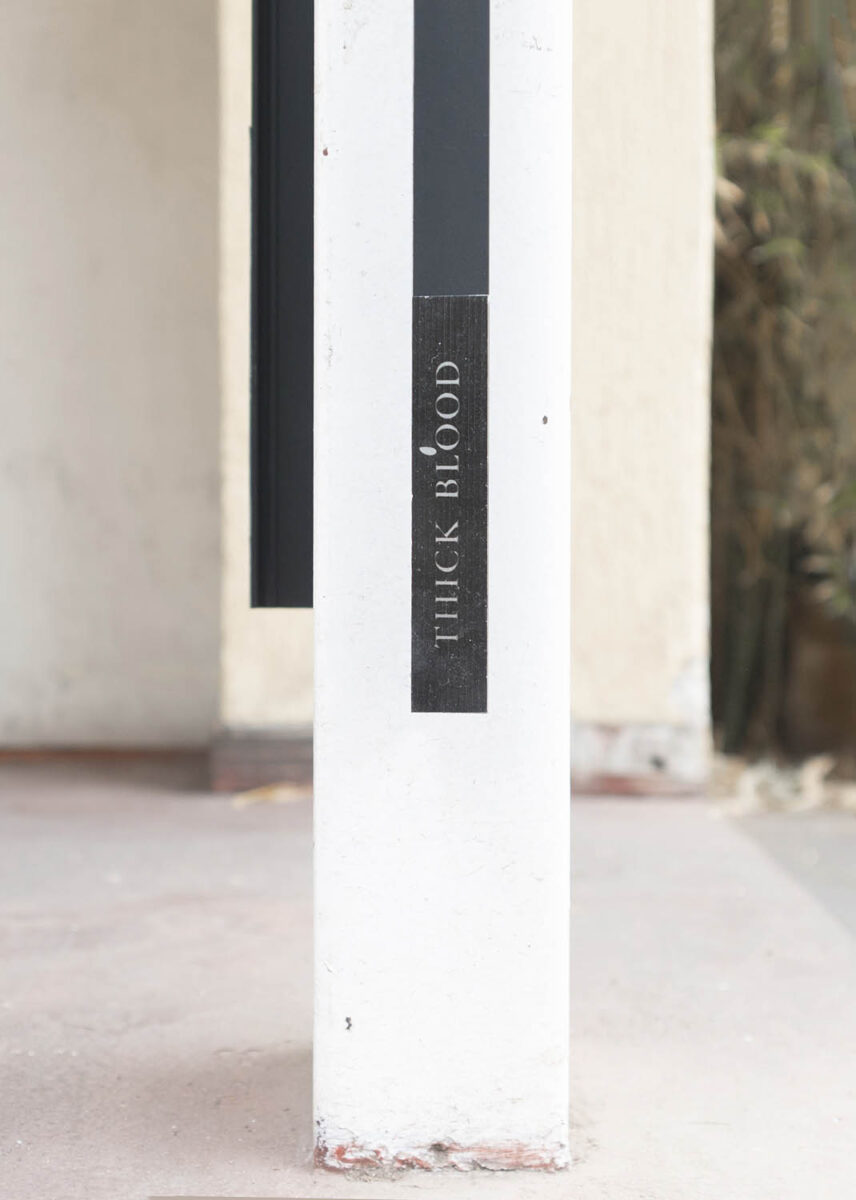
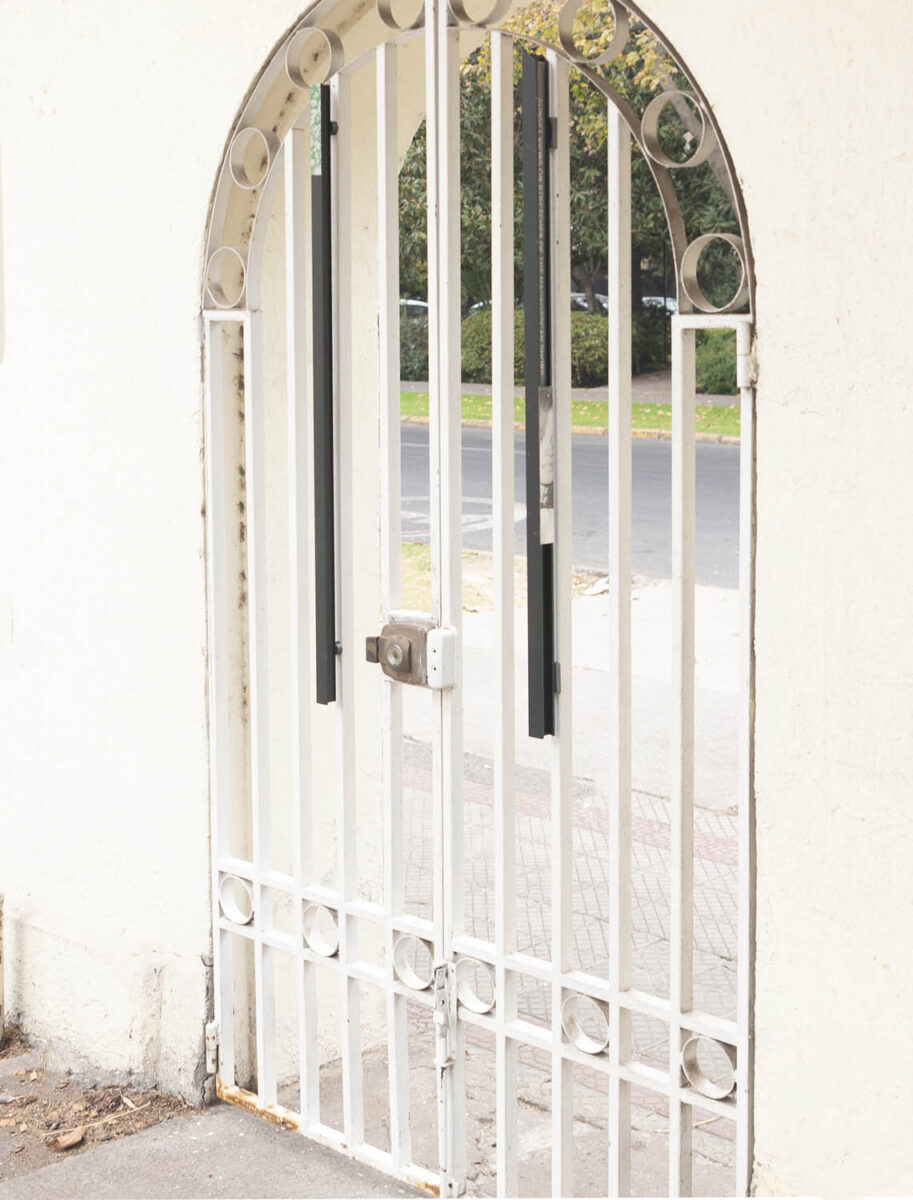
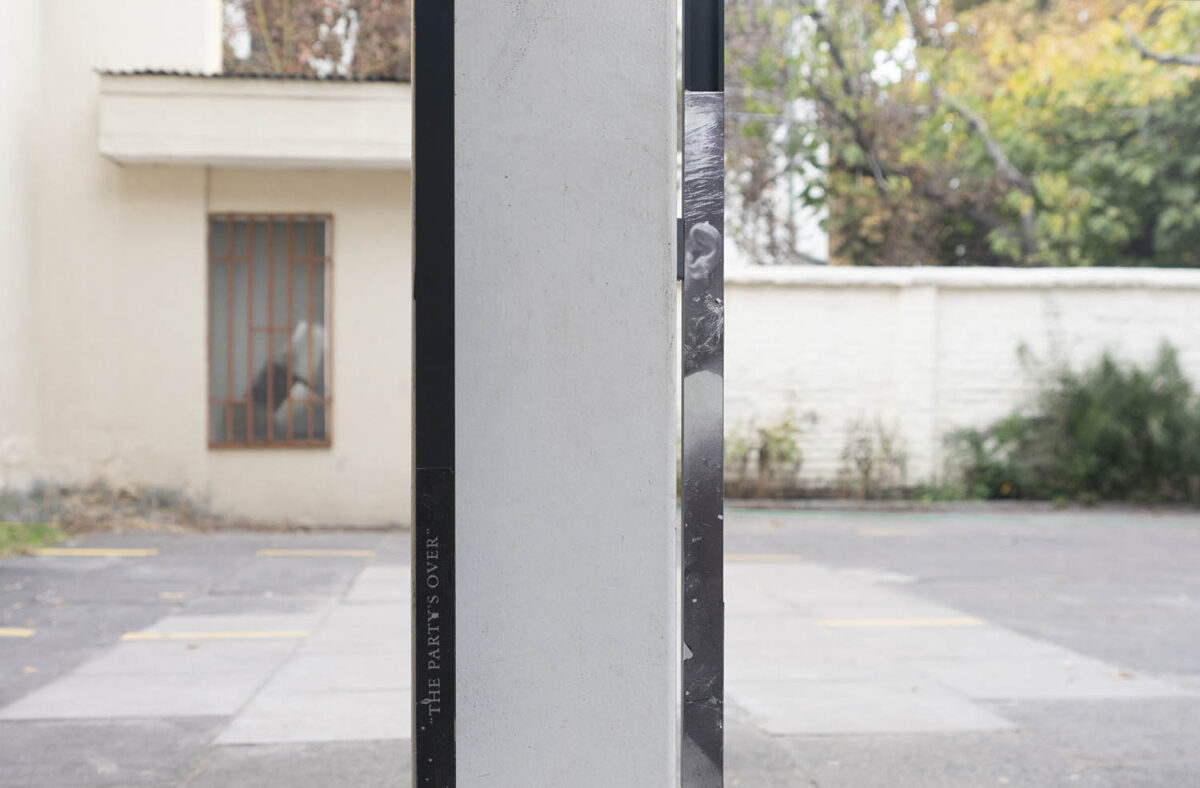
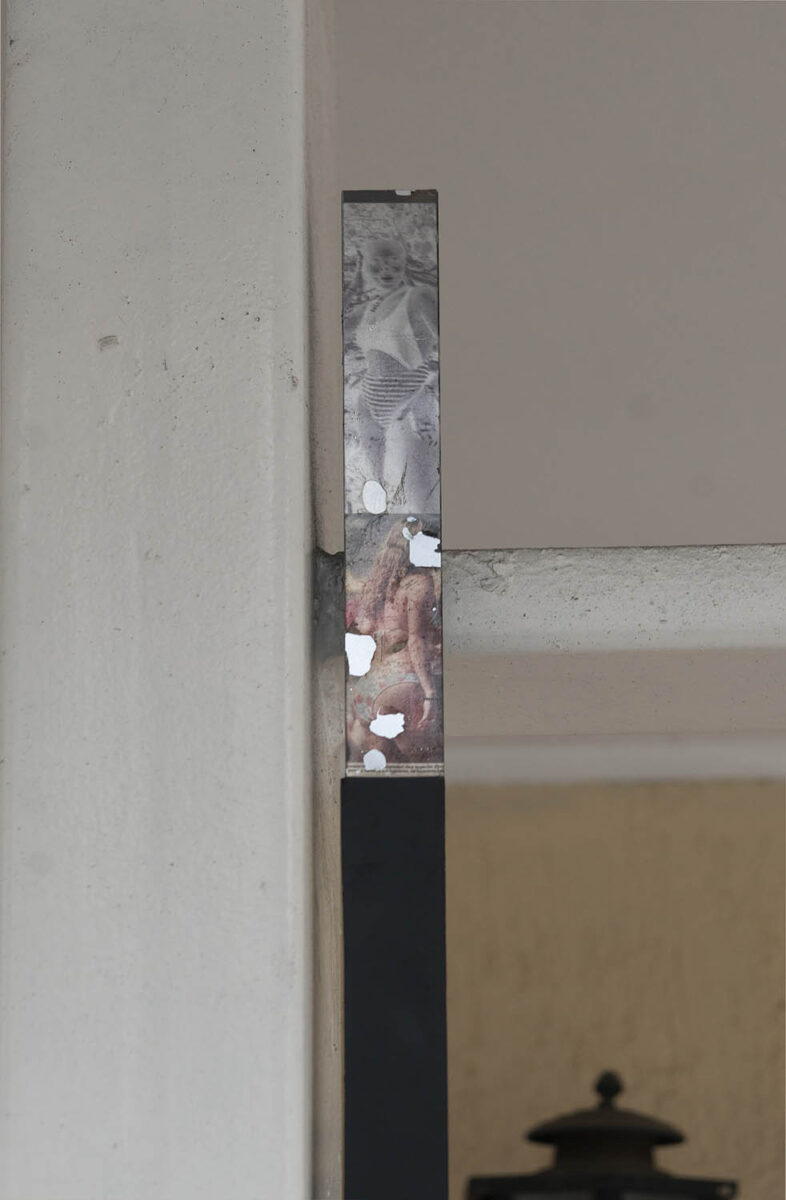
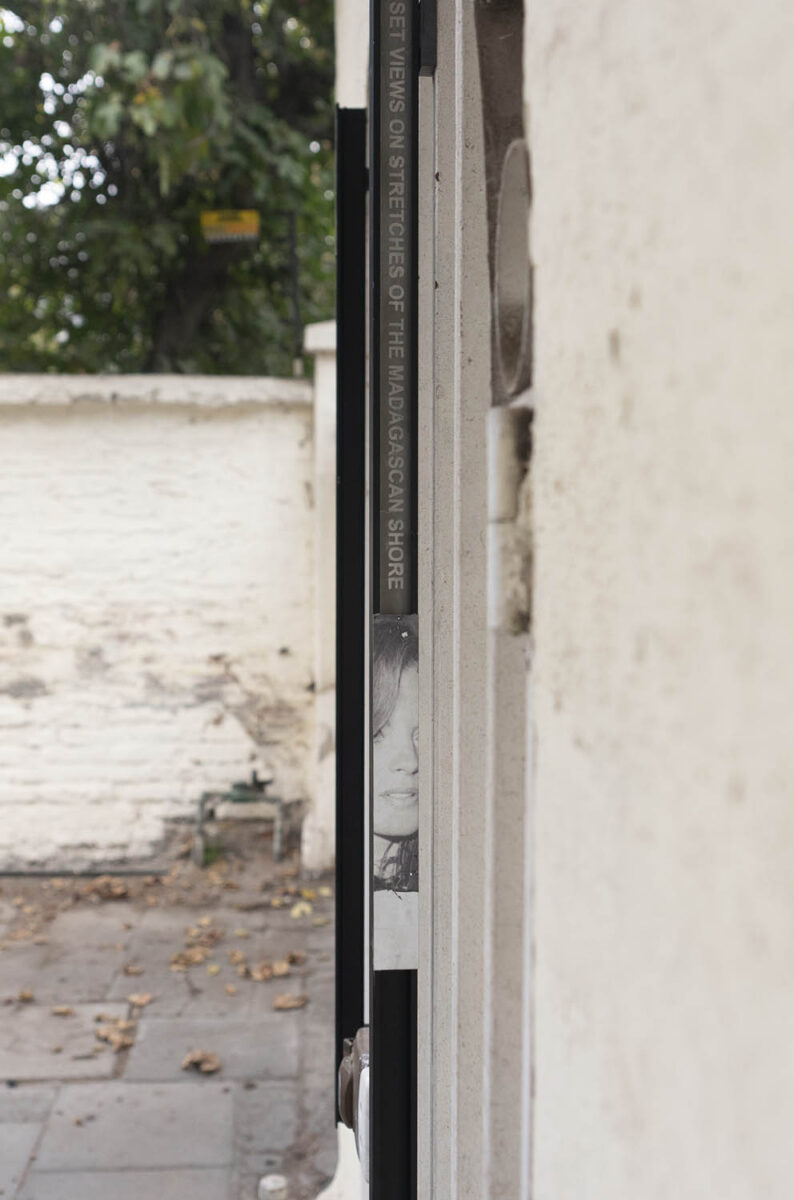
Paula Martínez Pastorino
HISTÓRICAS, Site specific installation, May, 2020, Santiago (Chile)
I made a visual memory game that contains – in disorder – the word “HISTÓRICAS” (allusion to 8M 2020 in Chile, my last physical / corporal / collective memory on the street before entering preventive quarantine). I hung from the top floor of the building 10 sheets tied together vertically (which were donated by different people in order to carry out this work), where each module contains a letter/drawing in sanguine per face. In a nutshell, it is a large-scale vertical mobile memory.

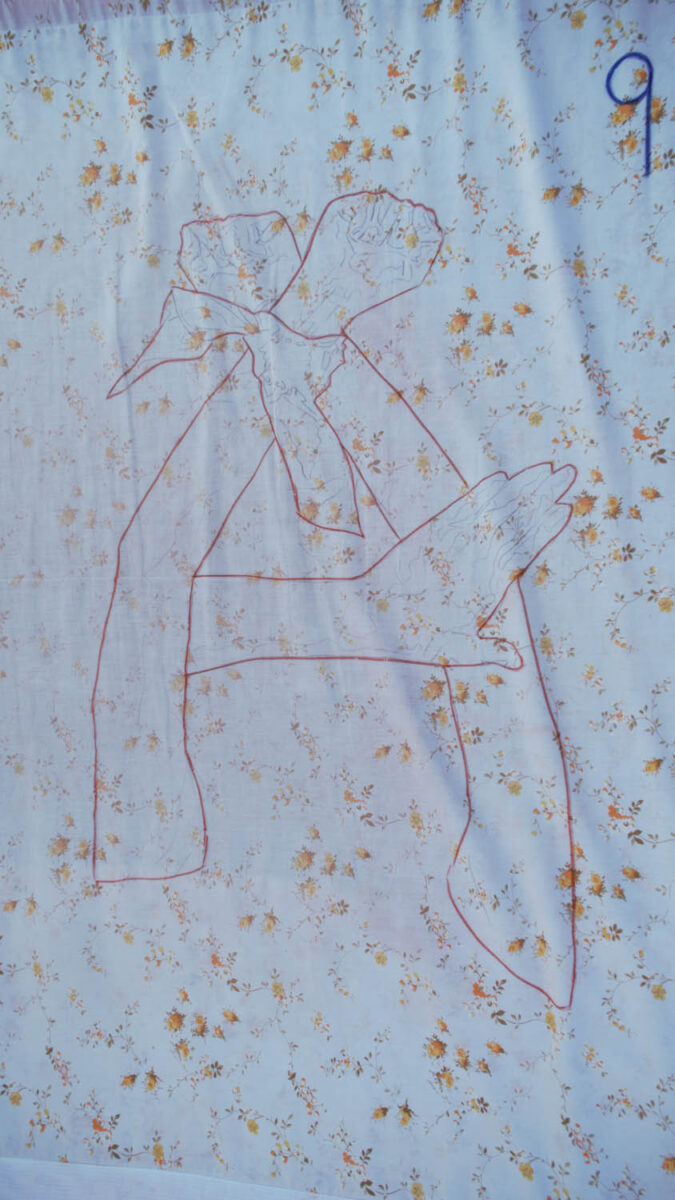


Pilar Quinteros
Lady Covid, Performance and video, May, 2020, Coyhaique (Chile)
In March, I traveled to Coyhaique to produce and record a short film in the context of the art residence “Traslado”, of the Ministry of Culture and Arts of Chile. I had everything planned, always leaving big holes to give space to what should be, to what one was to discover. However, those margins overflowed with the Coronavirus. Everything was postponed.
I stayed in Coyhaique to finish the cardboard, plastic and fabric pieces that I planned to use for the short film, store them in a cellar and leave. Thereupon, my flight back to Santiago was also suspended and I had to stay here throughout April.
I write this on May 19. I could travel to Santiago in three different buses, but the extension of the trip and the recent announcement of Total Quarantine there discourages me. I’ve decided to stay in Coyhaique because the city is practically closed and there have been weeks without new cases of Covid. We can do almost everything customarily, but maintaining social distance, complying with the curfew (curfew!) and wearing a mask everywhere we go. It is difficult for us to follow the rules of this game, since there is an absence of cases, one feels particularly absurd, I think. Here the Corona simply does not exist.
If I don’t take the Covid out on the street, he can’t be seen anywhere. There are no infected, nobody is sick, we are re-isolated, but we still have to keep playing. What specifically? Or are we being punished for protesting massively, as an international community? They just locked us up, put us in our place. If so, we must stop taking this disease seriously, not worse than many.
We have to go back to the street. I said it, there it is. Go out dancing with Corona, as with all our problems. There is too much to do.
Rodrigo Castro Hueche
En Toma (Intake), installation, May, 2020, Santiago (Chile)
Intake is a demographic installation that consists in an intervention of the facade of my current residence, assembling a series of materials and objects collected from the street on its grating. Most of them correspond to remains of furniture or wooden elements. These same discarded materialits are used in the land intake that is carried out as a counter-systemic response to the insufficiency of the State to maintain and house all the people who, due to different impoverishment processes, were forced to take their land. Likewise, I took my house, creating a contrast with the neighboring residences, where the situation of social class and the unfulfilled promise of a decent home to live was stressed. Demands of dignity that since October 2019 have been requested in social protests, until today that, due to the contingency, have unfortunately had to be suspended.

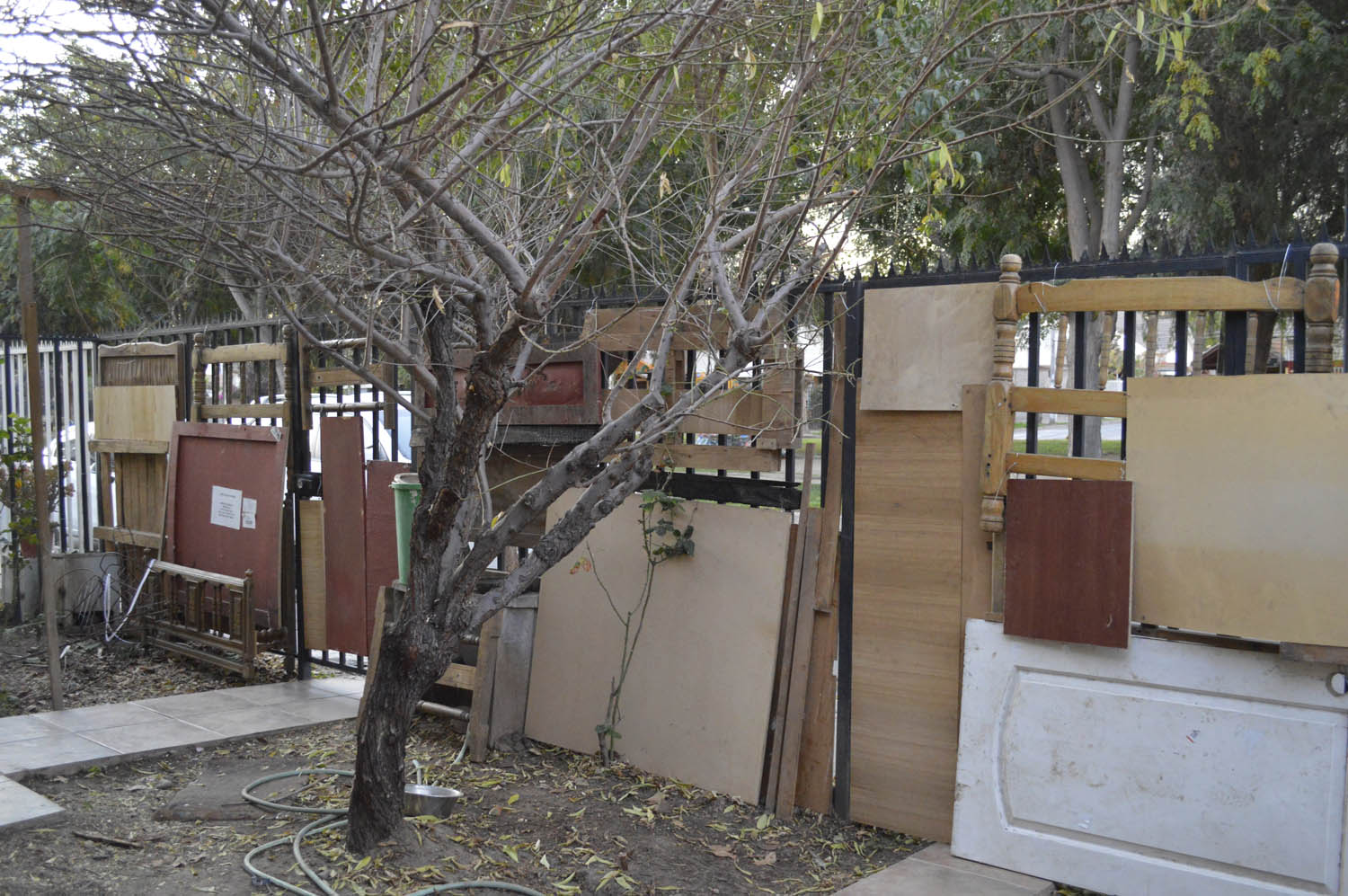
Sebastián Calfuqueo
Kal kutun / Hacerse brujo / Become witch, Colihue canes, elastics and black synthetic hair, May, 2020, Santiago (Chile)
The work consists of 2 rectangular colihue cane structures joined diagonally and intervened with braided synthetic hairs. The hairs form the phrase “kalku”, translated as “witch” in the “Araucanian-Spanish Dictionary – Spanish-Araucanian Dictionary” made in 1916 by the Capuchin missionary Fray Félix José de Augusta.
The work questions the models imposed by the West in relation to the spiritual and cultural practices associated with the use of hair, “kal” in Mapudungun, in a play on words with the term “kalku” (witchcraft) dragged down by the legacy and imposition of the Christian religion and the idea of ”evil” that was applied to indigenous cultural practices. “Kalkutun” refers to the action of becoming a witch, a metaphor for the possibility of connecting the artist’s immaterial with other culturally denied knowledge.
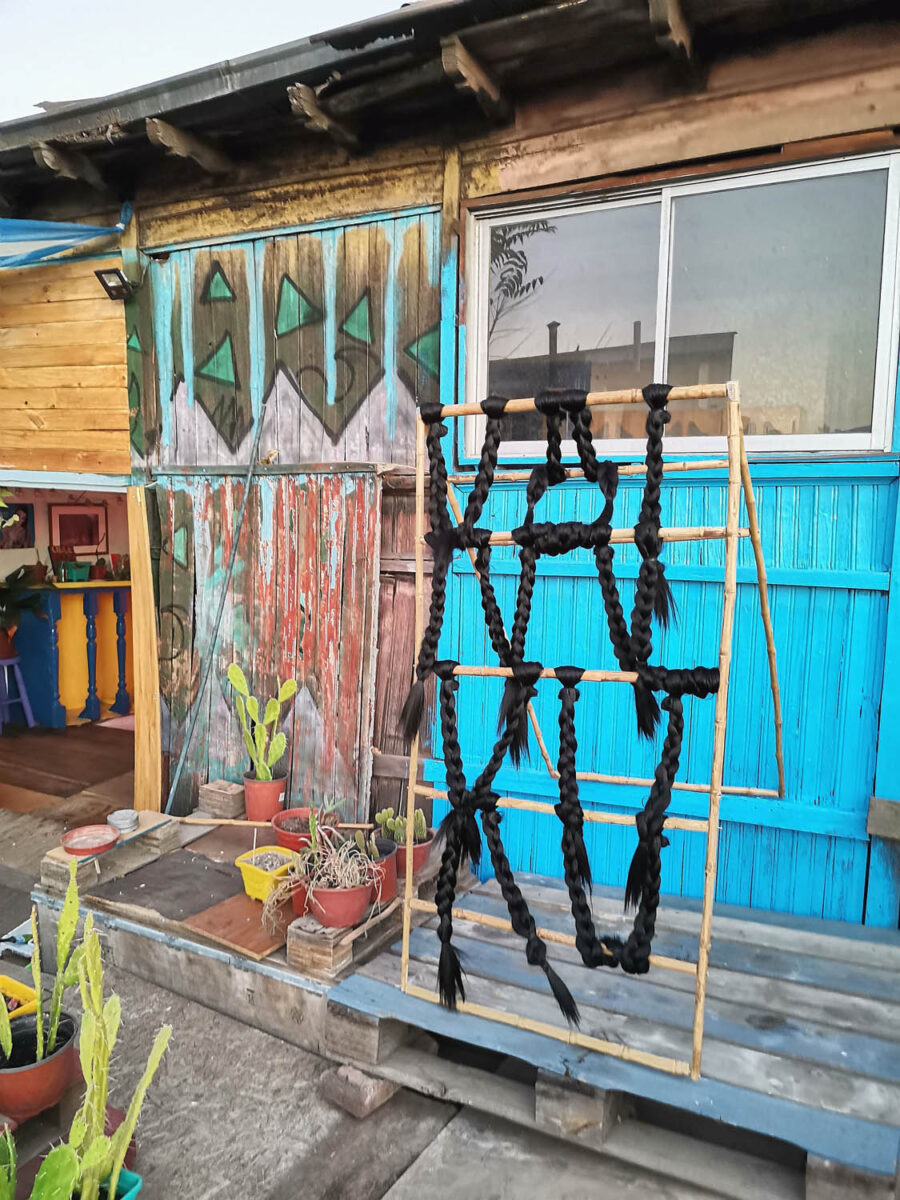
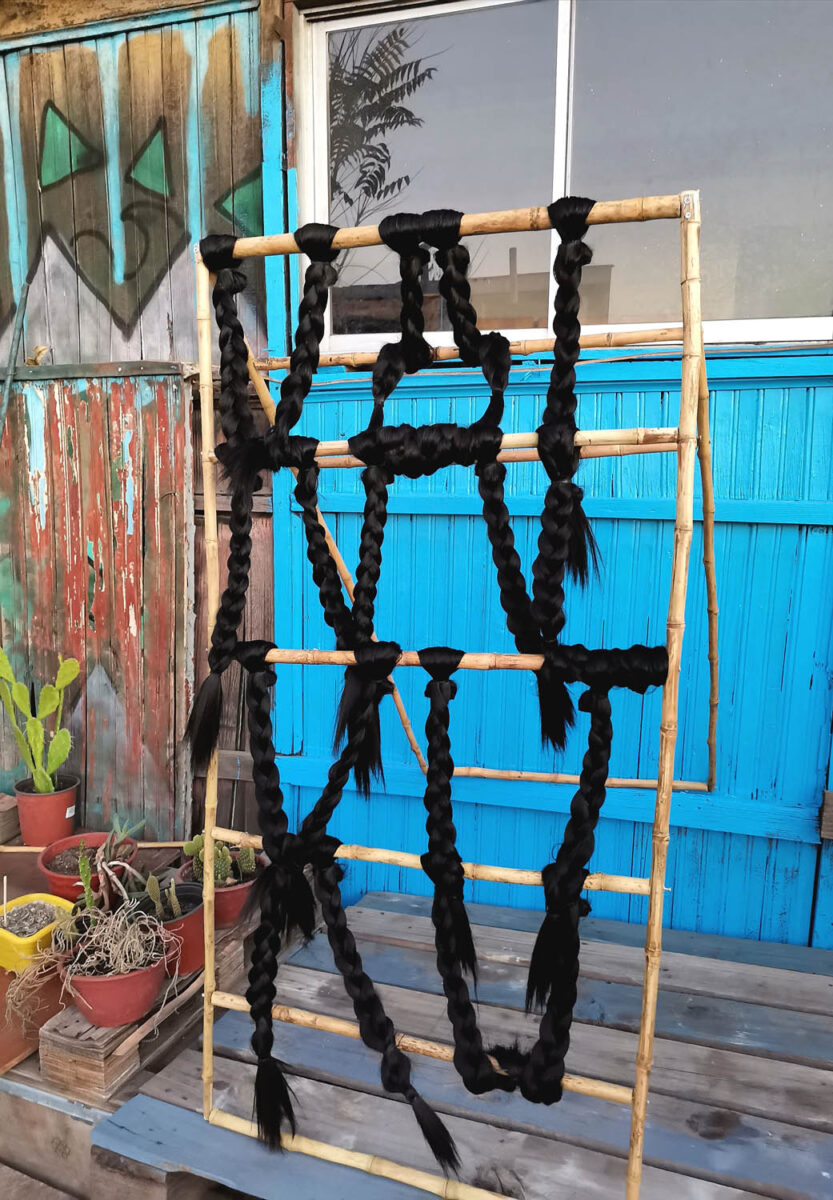
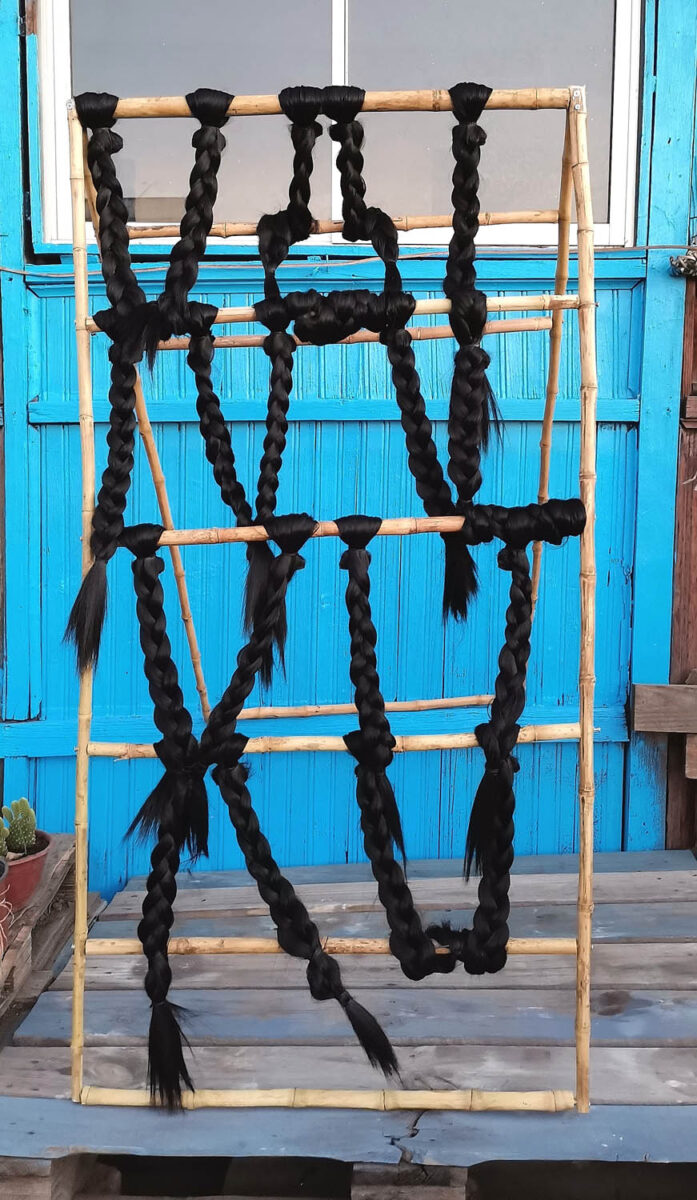

Sebastián Mahaluf
Reptación (Creeping), Performance and video documentation, May, 2020, Santiago (Chile)
The project consists of a video performance, distinguishing an interior from an exterior.
In the beginning, Lara’s Theme sounds, a song composed in 1965, for the movie Doctor Zhivago, by Maurice Jarre. Then a fixed shot on my face covered with parts of a costume of red acrylic beads -performing costume that I have used in previous works-.
Outside, a zenith scene is shown presenting the location, where there is a large red cloth fabric that covers the pavement. My body lies underneath and begins to move along with the fabric, until I discover the sign: stop.
The shots, both inside and outside, are interspersed and linked by the sound of the song, interspersed with underwater audio and satellite sounds.
Textileras MSSA
Por una Vida Digna (For a Dignified Life), collective textile canvas, May, 2020, Santiago (Chile)
For a Dignified Life (Por una Vida Digna), a collective textile canvas, was exhibited on the facade of the Salvador Allende Solidarity Museum (MSSA) between May 12 and 19, 2020. In the context of physical distancing and quarantine due to the current health crisis, the facade of the museum was intervened with the aim of keeping alive the mobilisation and civic organisation deployed during the social outbreak in October 2019.
The canvas was created by Textileras MSSA during the months of October and November 2019, in collaboration with residents of the Barrio República in Santiago, territory where the MSSA is located and where much of the work is carried out by the group. The textile was made through workshops open to the community at the neighbourhood square, where more than 40 people of all ages participated and were invited to express their feelings about the revolt and the territorial action.
Textileras MSSA is a group of women workers in the textile arts, who meet, recognise themselves and advance adding others from the trade and from the community creation.
Canvas made by the Textileras MSSA (Weavers of Museum of Solidarity Salvador Allende) together with residents of the neighbourhood, since the social outbreak, hanging on the facade of the Museum of Solidarity.
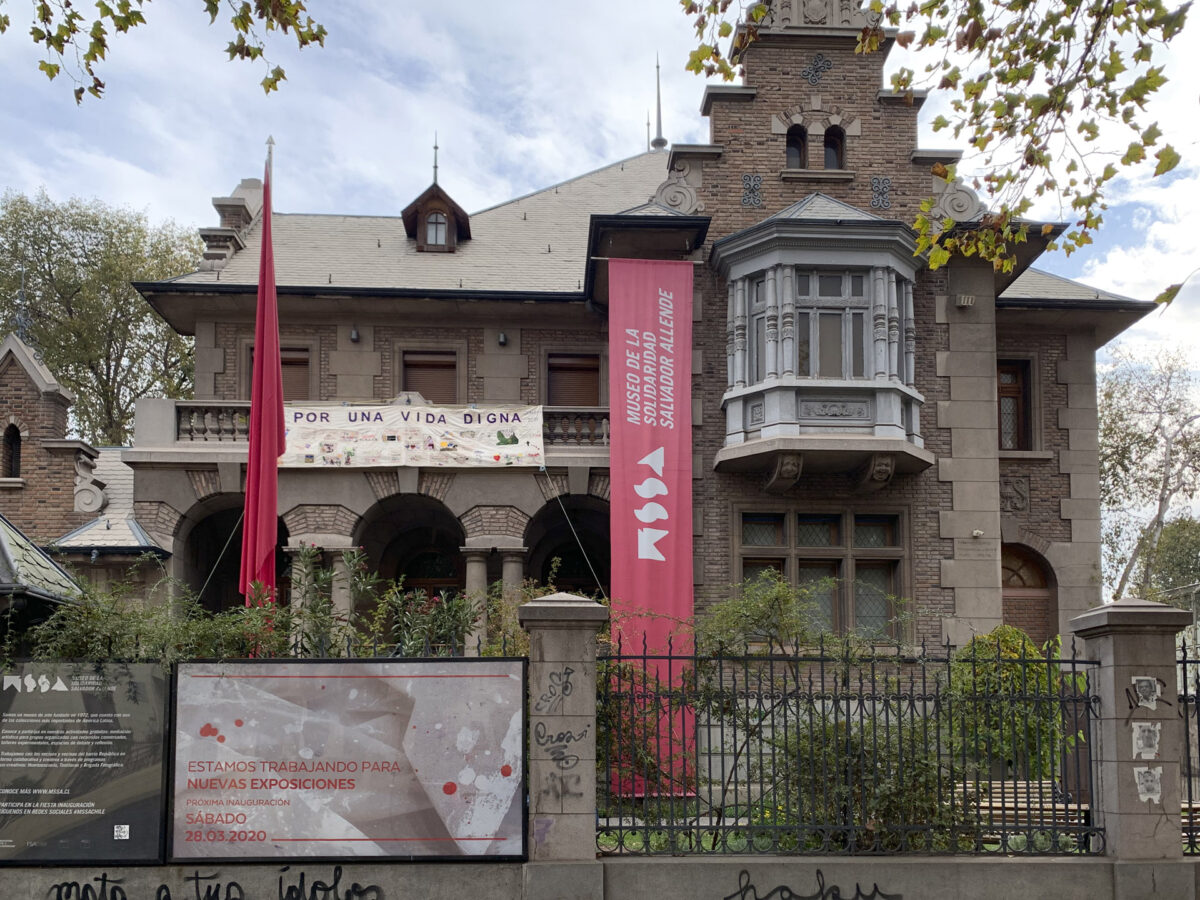
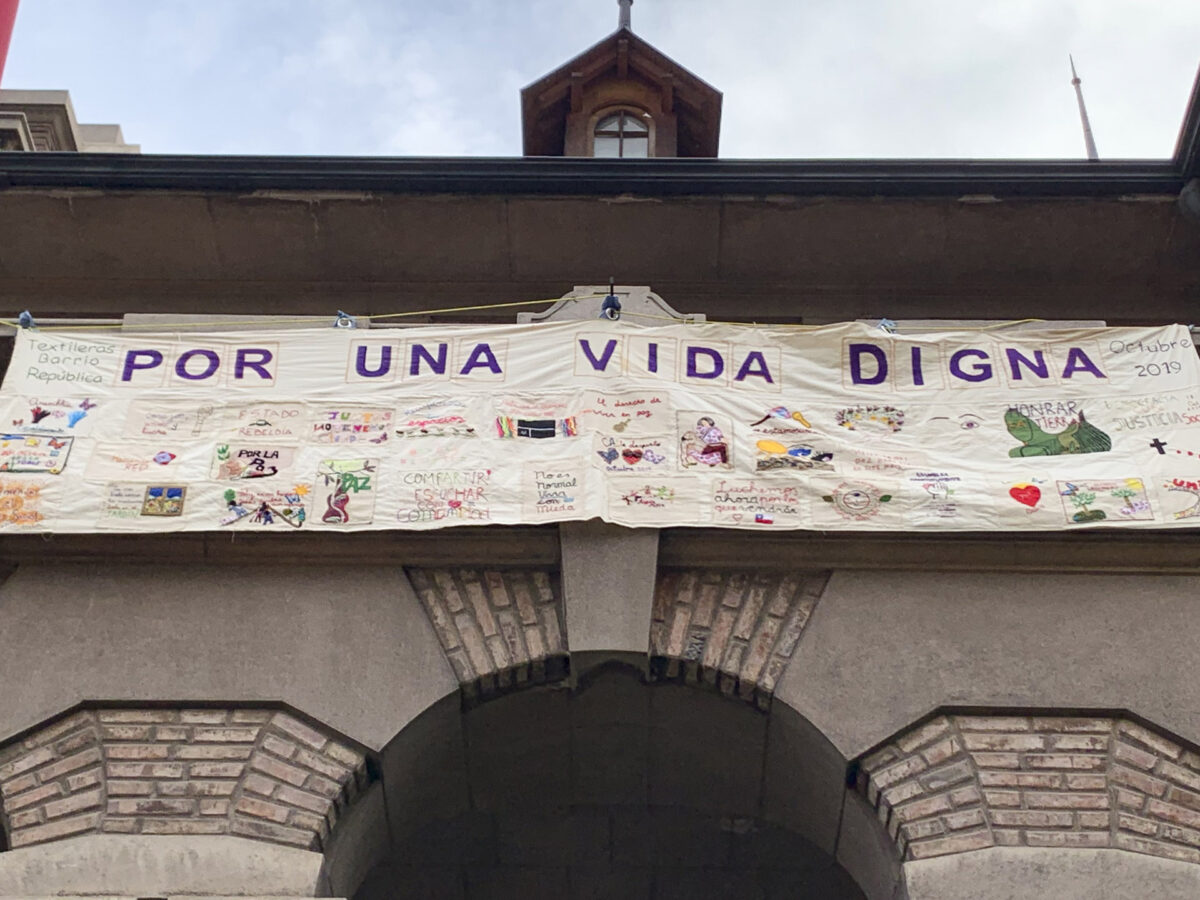
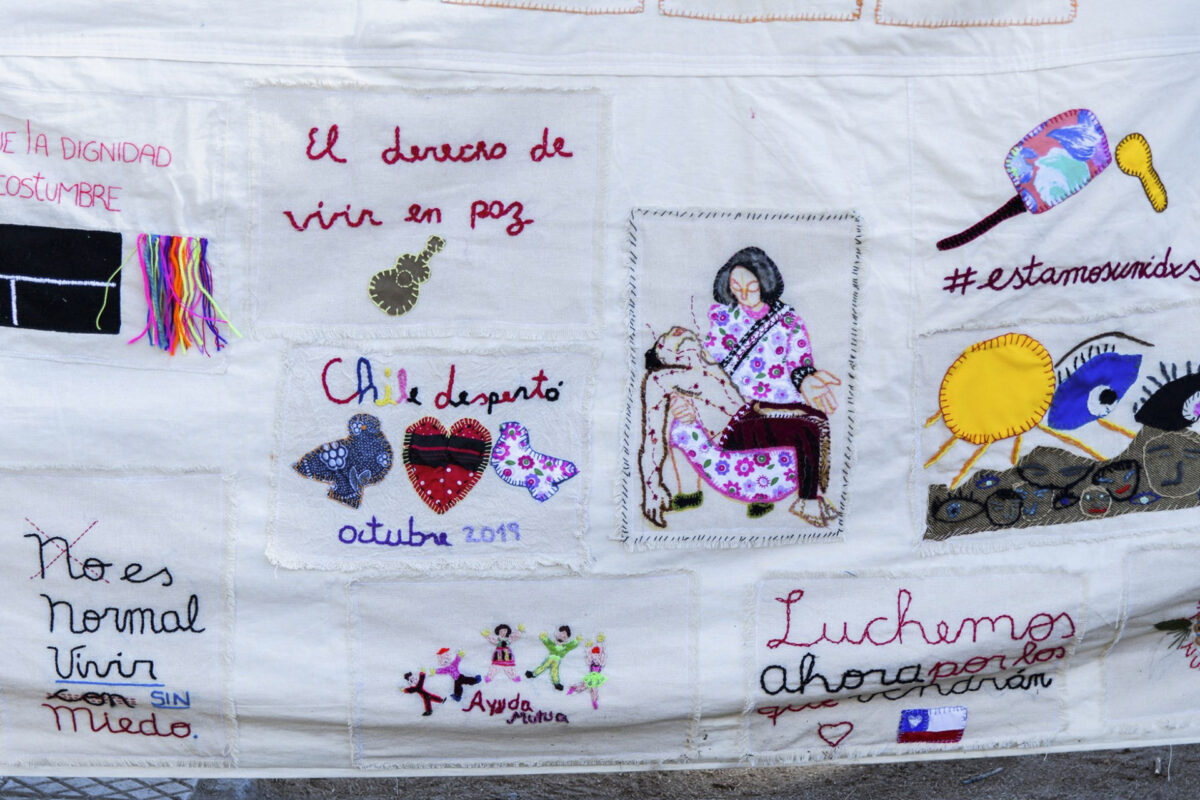
Victor Flores
PLAN C, Performance, May, 2020, Santiago (Chile)
This operation arises from a performance (PLAN C) that I did in 2009 at the extinct Moto Gallery, in an exhibition titled Plan B.
My current project reactivated the same action but from the front garden of my house that overlooks Sierra Bella Avenue in the Mata Sur neighborhood, Santiago Centro. I was in the front yard of my house wearing the same white criminologist suit, gas mask and airtight goggle that I’ve used in 2009, but the difference this time is that instead of smoke bombs I activated and emptied two 6-kilo fire extinguishers .
The action was musicalized with a song by a Chilean hip-hop band called Los Brujoz. The song is called Futuro paralelo posible.

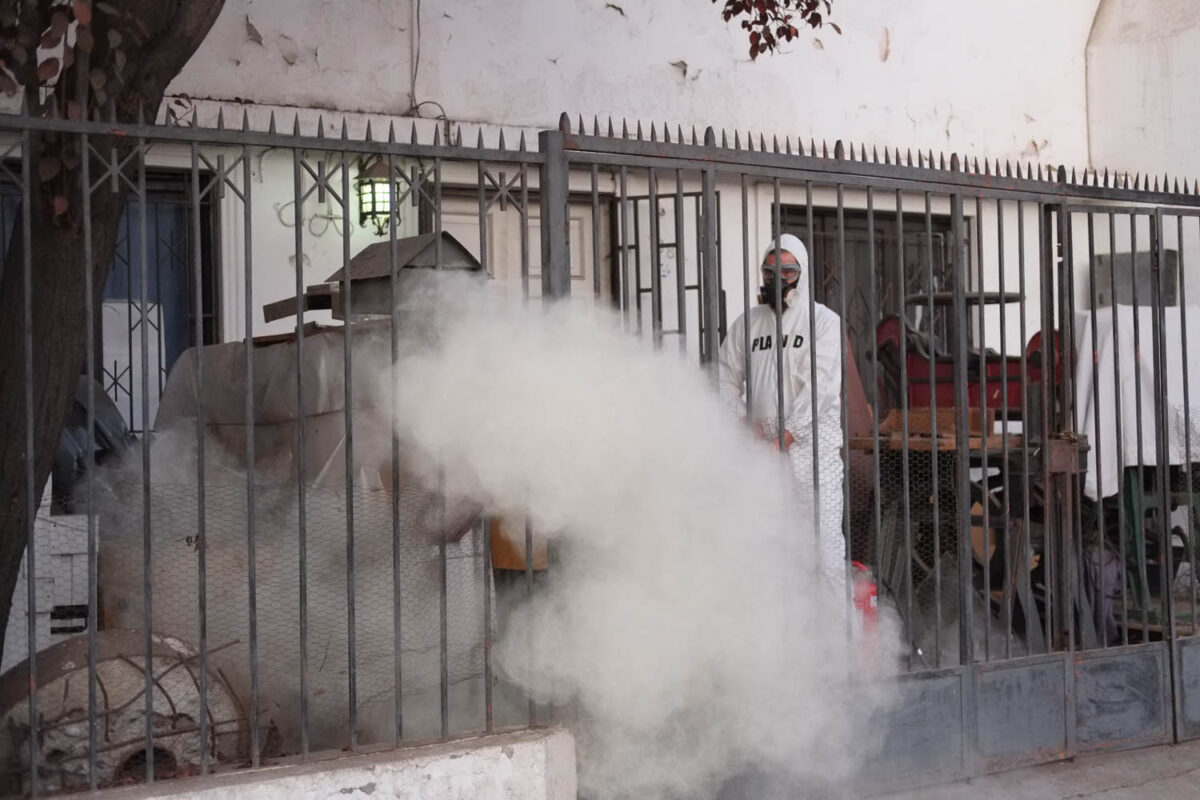

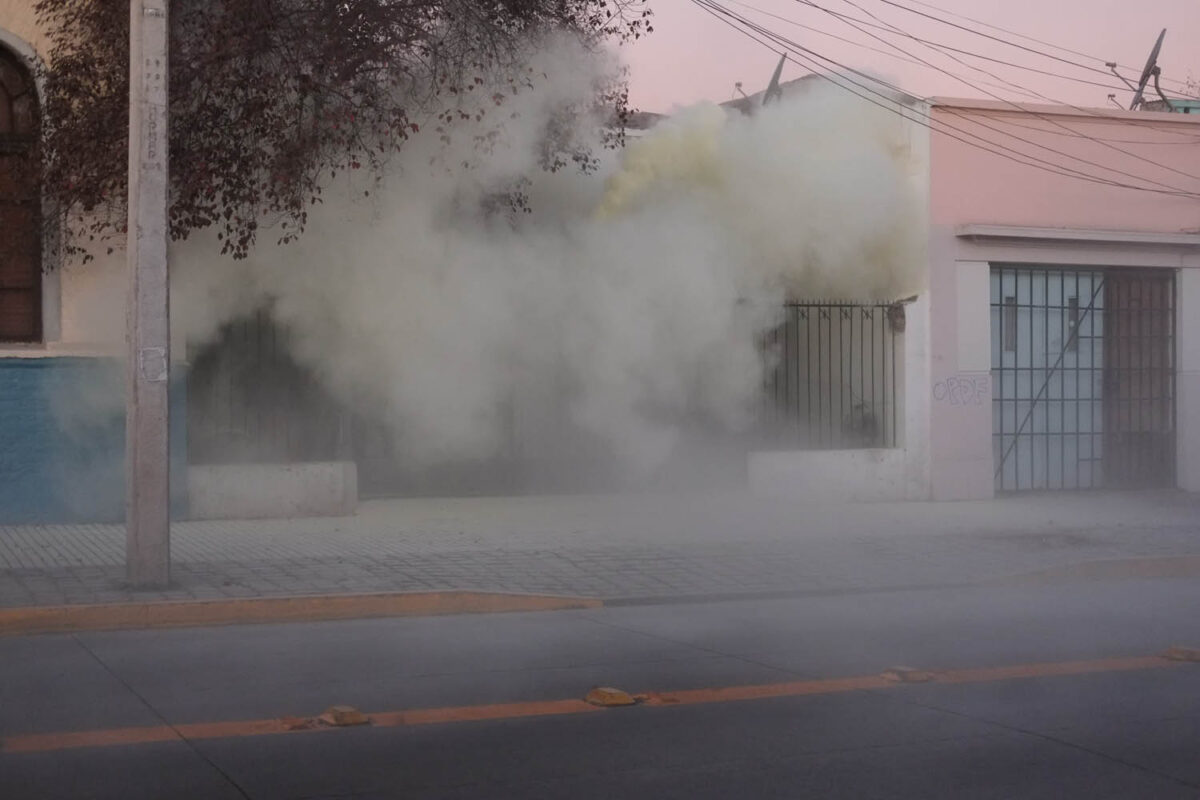

Ximena Zomosa
Sin titulo (Untitled), Performance, May, 2020, Santiago (Chile)
I’ve made a move from my apartment to the nearby supermarket (about a block away) of a five-meter-long flowered apron. The action was developed by the two people I live with, my 24-year-old daughter and my 21-year-old niece. We spread it out in the parking lot, I registered it, and we returned.
Acknowledgements: Adolfo Bimer, Alejandra Araya, Alejandra Wolff, Alfonso Díaz, Alonso Yañez, Alvaro Balcazar, Ana Belén López, Andres Soffia Vega, Angélica Muñoz, Anita Lira, Antonia Morales, Antonio Bascuñan, Bettina Rodríguez, Cecilia Toro, Daniela Munizaga, Diego Ramírez, Carlos J. Nuñez, César Vargas, Carolina Zañartu, Carolyn Gárate, Catalina Scopesi, Claudia Zaldivar, Clemente Merino, Daniela Isabel Munizaga, Daniela Vega, David Guzman, Davison Pereira, Elodie Fulton, Eva Japaz, Fabiana Herrera, Felipe Aguayo, Fernanda Bustos, Fernanda López, Fernanda Pizarro, Francisca Sáez, Francisca Santa María, Francisco Cartagena, Galo Navarro, Garvo, Gepe, Gianina Correa, Hector Polanco, Herta Vassallo Rocha, Ignacia Biskupović, Ignacio Navarrete, Ignacio Pimentel, Irma Sepúlveda, Javier Mansilla, Javiera Mallia, Jorge Campano, Juan y Joaquin, Kenfa Wong, Leonardo Beltran, Lucía Lopez, Maite García, Manuel Vlastelica, Marcelo Mendoza, María Teresa de la Fuente, Marivel Santana González, Museo de la Solidaridad, Natalia Holvoet, Oscar Contardo, Övül O. Durmusoglu, Ramón Castillo, Rodriga Riera, Rodrigo Merino, Sagrada Mercancía, Sebastián Orueta, Simón Jarpa, Sofia de Grenade, Soledad Larrain H., Strahinja Bousquet, Tomas Carrasco, Tarix Sepúlveda, Typerepublic, Valentina Martínez, Varinia Brodsky, Vicente Merino, Victor Leyton, Virginia Migani, Ximena Correa.
